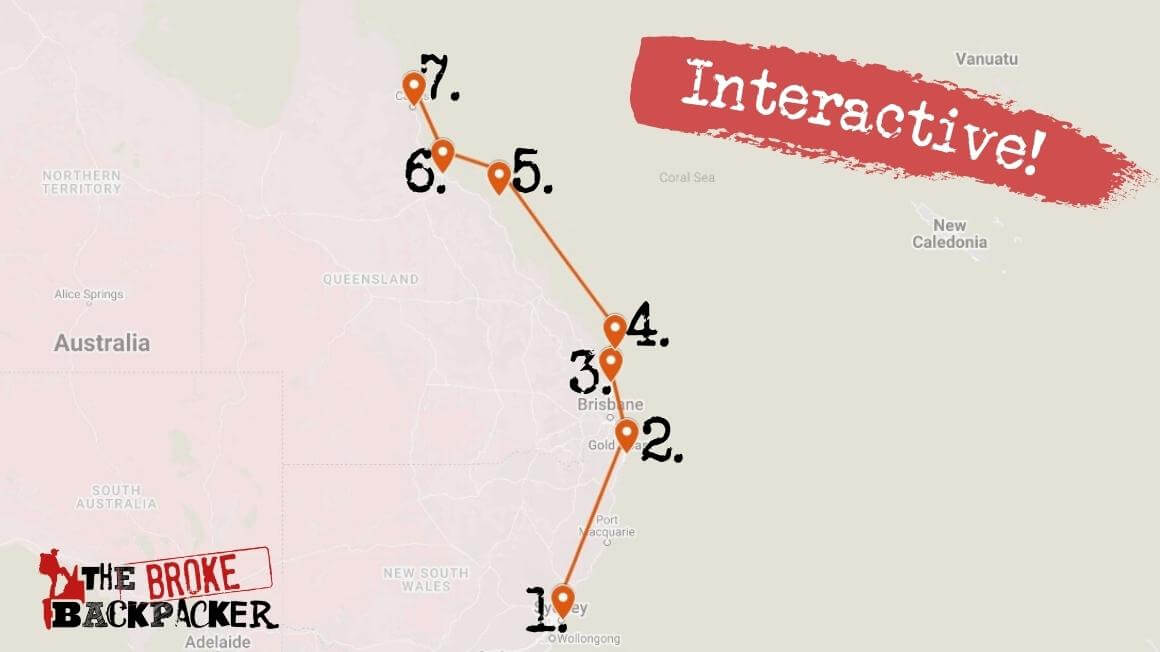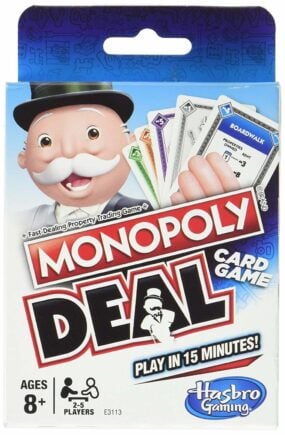When I ask you to think of Australia, what comes to mind?
Do you dream of hanging out with bouncy kangaroos? Or, driving a van through the outback? Or, maybe your mind takes you to explore the big cities? Or, surfing epic waves along the coast?
All of this and more is possible when you embark on your adventure – backpacking in Australia.
Whether you want to load up a van and hit the open roads or dive deep into the Great Barrier Reef; there is an Aussie backpacking itinerary that will suit every traveller. You just need to get clear on what you’re after and what this magical land down under has to offer you.
Australia is absolutely HUGE (like seriously massive) and it is so diverse. From the bustling streets of Sydney to the wild outback; there is so much to see and do when backpacking down under. It can almost feel overwhelming! But I’m here to help you make sense of it all.
In this guide, I’ll take you through everything you need to know to make the most of your backpacking trip in Australia. From the best itineraries to the boring stuff like travel insurance – I’ve got you covered.
So, without further ado – it’s time to head down under!
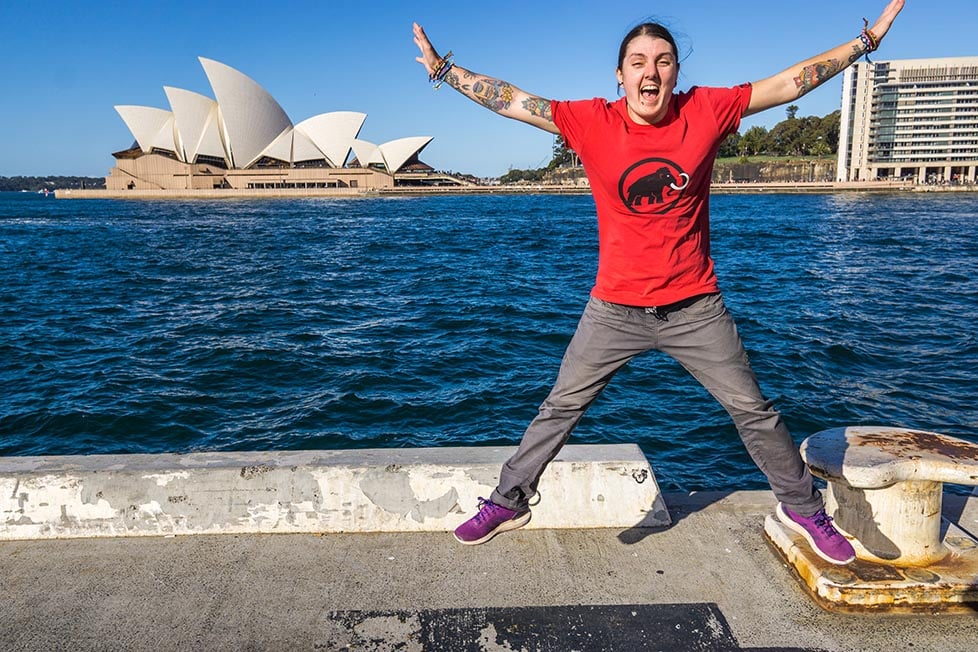
Image: Nic Hilditch-Short
The Broke Backpacker is supported by you. Clicking through our links may earn us a small affiliate commission, and that's what allows us to keep producing free content 🙂 Learn more.
Why Go Backpacking in Australia?
Australia is a huge country with tons of things to do and see! From sailing around the Whitsunday Islands to diving in the Great Barrier Reef to road-tripping just about anywhere, Australia’s got it all.
It’s kinda a rite of passage for any backpacker to visit Australia. We all have that friend who went for a year’s working holiday and ended up staying forever… Why do you think that is?
The country itself is beautiful and there are so many different types of landscapes and wildlife, from croc-infested wetlands to sparse deserts and dense rainforests.
But more than that, Australia has some of the kindest, most welcoming, hilarious people. Anyone who visits Australia feels completely at ease.
There’s a relaxed vibe here. It can’t be described: you just have to go and find out for yourself.
- Best Travel Itineraries for Backpacking Australia
- Best Places to Visit in Australia
- 10 Top Things to Do in Australia
- Backpacker Accommodation in Australia
- Australia Backpacking Costs
- And Speaking of Plastic… Get an eSIM For Australia
- Best Time to Travel to Australia
- Staying Safe in Australia
- How to Get Into Australia
- How to Get Around Australia
- Working in Australia
- Australian Culture
- Some Unique Experiences in Australia
- FAQs About Backpacking Australia
- Final Advice Before Visiting Australia
- Buy Us a Coffee!
Best Travel Itineraries for Backpacking Australia
Below is a list of travel itineraries for backpacking Australia. They vary in length and cover the majority of the must-see places in Australia.
When I went backpacking Australia, I had this epic tour planned out. By the time I got to Byron Bay, I fell so madly in love with the people that I’d met in Australia’s amazing hostels that I had to drag myself away after already extending my stop twice. My only regret is planning too much.
I suggest really taking your time. If you like a place, stop for a while! You’ll be pushed for time – even with 3 months – and you’ll encounter places you won’t want to leave. But ride the waves, dude.
Here are some ideas for your itinerary. Just make sure to leave plenty of wiggle room for the enevitable.
10-Day Travel Itinerary for Australia: Tassie
This is the best itinerary for tackling a Tasmanian road trip! You can travel in either direction or pick a city — other than the capital city of Tasmania, Hobart — to begin your route.
Starting in Hobart, the capital of Tasmania. This is the capital city and it’s best known for its port which is the gateway to the Arctic. It’s not a very interesting city, to say the least, so you’ll only want to spend a day or so getting orientated before moving on to the next destination, Freycinet National Park.
What’s most notable about Freycinet is the pink granite peaks, the private bays, and white sand beaches. It’s a great place to relax and enjoy some peaceful nature and wildlife.
Once you have had your fill of Freycinet, head over to St Helens, another big port city known for its deep-sea fishing. If you enjoy fishing, you’ll love it here. It’s also a good spot for diving enthusiasts, or if you just fancy lazing by the beach, the Bay of Fires is pretty epic.
Next up, is Devenport. This city is often overlooked by tourists as it’s just another port city, but because it’s so quiet you can really get a feel for Tasmanian culture.
Then, you’ll want to head to Cradle Mountain, the best place to visit in Tasmania for wildlife. Here you’ll see epic landscapes and also (if you’re lucky) Tasmanian devils, quolls, platypus, echidna, wombats, and the black currawong.
Once you’ve had enough nature, head over to Strahan, the gateway to the Tasmanian Wilderness World Heritage Area and Franklin–Gordon Wild Rivers National Park.
Once you’ve had enough of Strahan, head back to Hobart to head home.
2-Week Travel Itinerary for Australia: Sydney to Adelaide
See the best of Australia’s metropolis cities on this 2-week itinerary around the southeast coast! You could start this itinerary off in either ofthe major cities, Sydney or Melbourne. But for the sake of ease, let’s say we’re starting in Sydney.
The fake capital of Australia is home to iconic landmarks: Sydney Opera House and Harbour Bridge. Spend a couple of days getting lost in Sydney and enjoying some of the epic beaches of New South Wales.
Then, make your way south towards Melbourne stopping for a visit to Canberra. Canberra is a huge city that is most known for its government offices. Personally, I don’t think you need more than a day, but the journey from Sydney to Melbourne is long so it’s a good place to rest up.
Departing from Melbourne, travel along the sublime Great Ocean Road and earn glimpses of the stunning 13 Apostles and the Great Otway. Ocean Road is simply breathtaking.
It takes a few days to drive Ocean Road to Adelaide, so I suggest breaking it up. I suggest stopping at Port Fairy for a night and getting some rest here – it’s a small seaside town with not much to see.
There’s also a really great fish and chip shop here called Morriss Road Fish Shop and I had a great bacon cheeseburger… It’s the little things.
After spending a few days traveling on this road you’ll get to Adelaide, Australia’s most relegated and unknown big city.
Adelaide is a hidden gem just waiting to be discovered, this city is saturated with artists, amazing beaches, and tons of wine. After getting your fill here, grab a plane back to Sydney if you’re flying out from there. If you’re looking for a hostel in Sydney, I got you.
3-Week Travel Itinerary for Australia: The East Coast
This is the best itinerary for tackling an East Coast Australia road trip! Starting in Sydney, you should spend at least 1-2 days exploring. Take a day trip out to see the Blue Mountains National Park and marvel at the Sydney Harbour Bridge (or climb it, if you’re not scared).
After Sydney, it’s a long road to Byron Bay, the most famous beach in Australia and a hot spot for surfers. Personally, I found the beach itself crowded and underwhelming – but I met amazing people and spent nights laughing harder than I had in years.
I went on to the Gold Coast from here. I stayed with family and it was one of my favourite memories but there’s also some solid hostels here too. But unless you are a passionate surfer or love corny beach towns, it’s not a must-see.
Brisbane is a city that doesn’t get enough hype. I loved Brisbane and I cannot explain why. It’s just got a cool vibe and the nearby Gold Coast is simply stunning. I suggest spending 2 days in Brisbane, but no one would blame you if you wanted to stay longer.
Next up, if you’re tired of Aussie cities and want something a little more slow-paced, don’t miss Noosa. Backpackers rejoice: there are some banging hostels here and it’s also a world-famous surfing destination.
If you don’t like surfing, you can also go hiking in the Noosa National Park and rock climb some cliffs. I met up with people I previously met on the road here and it was well worth it. Plus, Noosa has some awesome places to stay around here.
Next, you’re going to head to Fraser Island. This unspoiled island is a nature reserve and it’s definitely worth staying actually on the island if you can afford it. You’ll also find plenty of yoga retreats in this area.
You can’t swim in the ocean, but I tell you, you won’t want to because you can see whales swimming in the ocean right from the shoreline! Make sure to check out the abandoned shipwreck too.

Image: Nic Hilditch-Short
After 2 days on Fraser Island, head to the Whitsundays, my favourite spot on the East Coast. The Whitsunday islands are untouched nature reserves, and you can only access most beaches by boat. This is a ‘take only photographs, leave only footprints’ kind of beach.
The sand is pure white and the ocean is a dazzling blue. You’ll never see anything like it. You could even look at it from up in the clouds by taking a Whitsundays and Heart Reef 1 hour scenic flight. You’ll see the kaleidoscopic colours of the Great Barrier Reef.
Next up, is Townsville. The actual town isn’t that impressive, but people often stop here to go to Magnetic Island. It’s also a great place to stop if you like diving and want to explore the Great Barrier Reef.
Finally, you’ll get to Cairns. This is one of the coolest cities in Australia, in my opinion. It’s surrounded by rainforests and expansive beaches and has a cool surfer-town vibe. Spend a few days chilling out here in one of the oh-so-cool hostels and then fly back to Sydney.
3-Month Travel Itinerary for Australia: The Land Down Under
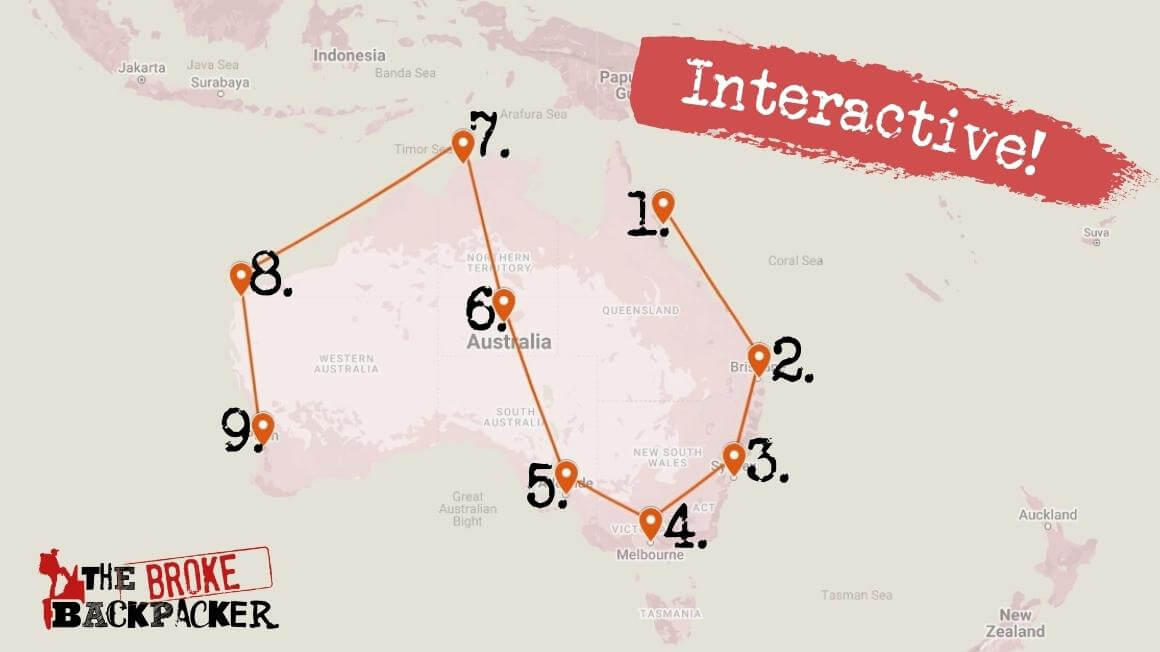
For this epic trip around Oz, this itinerary combines all you’ve seen above, with the addition of a few small-town stops. This route for backpacking Australia is pretty big. If you buy or rent a car, you’ll have complete freedom.
Let’s start by the Great Barrier Reef in Cairns. Make your way down, through Queensland. Surf the Gold Coast, dive Ningaloo Reef, trek Kakadu National Park; all of this and more is possible on this epic road trip through Australia!
Follow the East Coast itinerary to Brisbane, down to Sydney, then backpacker favourite: Melbourne.
Adelaide, the most underrated city in Australia is the gateway to the outback. Catch the iconic Ghan train to Darwin. The train takes 24 hours – but not in one hit.
It stops in Alice Springs, a large town in the middle of the red desert. Spend at least 3 days!
If you fall in love, how about spending a month backpacking route for Australia in the Outback? Visit top destinations like the mighty Uluru, Kimberly, and the Nullarbor!
Then, on to Darwin. Many people don’t know that Darwin has the most incredible sunsets in Australia. This coastal city has a relaxed, hippy-ish vibe and is where to learn about aboriginal history (being the closest spot to Kakadu National Park).
Head over to Broome, a beach resort town, west of Darwin. I recommend at least 3 days in Broome, bathing on the beaches lining the Indian Ocean, including the 22 km-long, white sand beach, Cable Beach. Venture into the wilderness or go looking for dinosaur tracks at Gantheaume Point. There are definitely a lot of cool hostels in Broome and some damn fine food too.
After that, enjoy Exmouth for pristine beaches and glistening blue waters. Here is the best place to explore the Ningaloo Marine Park – full of thriving coral reefs and migratory whale sharks.
Perth is a huge city with tons of character. It’s a great base to explore nearby beaches and wildlife. It’s worth spending a few days before flying back to Adelaide to finish your trip.
Want to save money on accommodation?
Enjoy 20% OFF on stays ALL around the world.
Best Places to Visit in Australia
As you can imagine, a country as vast as Australia is full of unique places to visit. Some major cities are spangly and new, like Sydney and Melbourne. Others date back to aboriginal times and feel strikingly different.
There is so much to unpack and discover that I can give you my favourite places to go in Australia. But inevitably, you’ll discover your own hidden gems.
Let’s take a look at the absolute most beautiful places in Australia!
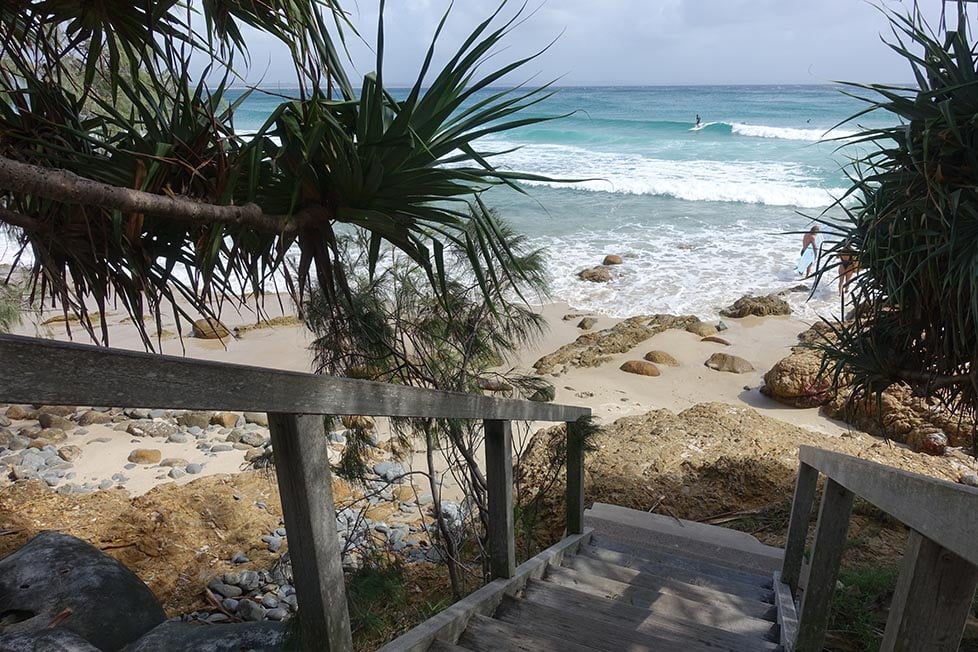
Image: Nic Hilditch-Short
Backpacking the East Coast of Australia
The East Coast of Australia, consisting of the states of New South Wales and Queensland, is the most popular backpacking route in Australia! The East Coast has some of the best infrastructure, greatest thrills, and most beautiful places in Australia. There is so much to do and see on the East Coast of Australia that we at Broke Backpacker had to create a separate East Coast backpacking travel guide to do it justice.
No trip to Australia is complete without a stop in this amazing part of the country.
Traveling 1500 miles from the ever-enchanting Sydney to Cairns affords travelers insane opportunities for adventure. You’ll navigate ancient jungles, go walking in the bush, and (of course) visit Australia’s damn fine beaches.

Image: Nic Hilditch-Short
Some other highlights of backpacking the East Coast of Australia include camping on Fraser Island, sailing among the picturesque Whitsunday Islands, and diving at the Great Barrier Reef.
My top highlight was probably feeling freer than I ever had in my life before. Meeting people who you immediately click with and change your plans for. It’s a remarkable experience.
Those interested in backpacking around this part of Australia should best refer to our informative guide where I break down heaps pertaining to New South Wales, Queensland, and everything in between. This includes the usual subjects like accommodation, itineraries, and how to get around.
Note that this guide will also cover locations that are not bound to the coast including the Atherton Tablelands and the Outback. You gotta see the desert while backpacking Australia even if you intend on being a beach bum 99% of the time.
Backpacking Canberra
Canberra is the federal capital of Australia and has a rap for being boring as hell. Famously, one former prime minister wouldn’t even live there when he was in office (though he denied any feeling any revulsion to the place). Truthfully, Canberra really isn’t that bad – so long as you know what you’re getting yourself into.
Canberra is a planned community that was designed to be a “garden city”. For this reason, Canberra has an extensive amount of parkland, national monuments, and cultural centers. At the center of everything is the large and artificial Lake Burley Griffin, which acts as a sort of reference point.
Around the lake are Canberra’s most prominent landmarks including both Parliament Houses (the old and new ones), the hallowed Australian War Memorial, and several museums and galleries. The National Museum of Australia, National Gallery, and National Portrait Gallery are all fine cultural centers worth visiting.
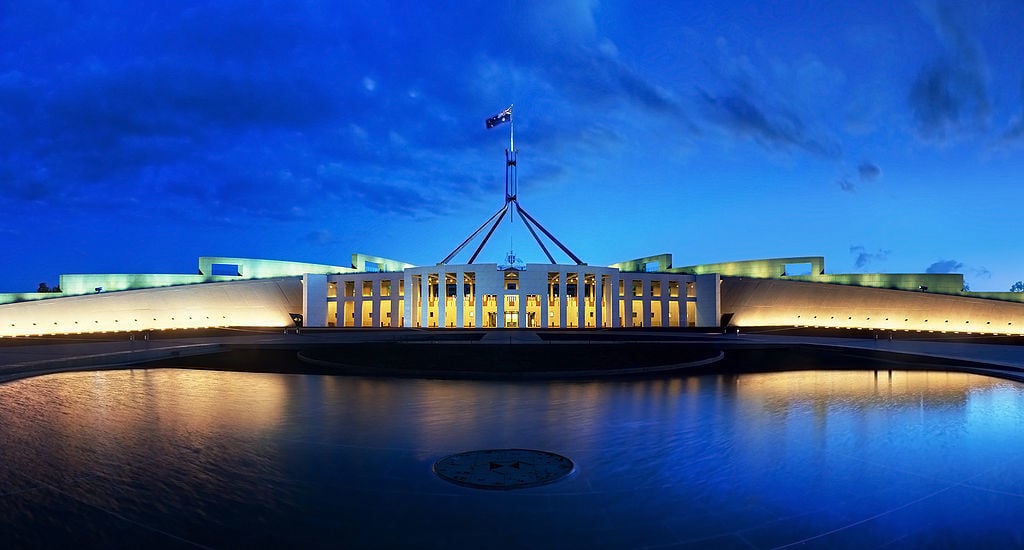
Photo: JJ Harrison (WikiCommons)
The best way to get around Canberra is by walking or biking. Thanks in part to abundant greenery and lack of traffic, these modes of getting around can be quite enjoyable.
Take note that Canberra is still quite spread out. So getting around on foot is a day’s work in itself.
If you find Canberra’s parklands insufficient, then there are plenty more pastoral sights outside of the city. Namadgi National Park is the northernmost section of the Australian Alps and has lots of outdoor activities. Mountain biking, in particular, is very popular around Namadgi and the highlands of Canberra.
Ultimately, Canberra is a fine city to visit for a weekend. Those backpacking around Australia should come here for the bucolic scenery and small-town lifestyle.
Backpacking Melbourne
Sydney’s greatest rival is the super-dynamic and culturally superior Melbourne. Melbourne is the former federal capital city and, for this reason, was once the center of all things Australian.
Melbourne lead the way in economics, art, sports, you name it, until Sydney rose and began to challenge it. Backpacking Melbourne is a fun and interesting experience.
Melbourne is a huge city with multiple districts. Most of the top things to do in Melbourne are found around the city center – in the CBD and Southbank. The CBD is buzzing constantly with action: here are some of the best cafes, bars, restaurants, and cultural sites in the city.
Flinders Street Station acts as the central nervous system of Melbourne and provides transport to any and all of the metropolitan area. Very close to the CBD are St. Paul’s Cathedral and Collins Street, the latter of which is very fucking cool.
Other notable attractions, like the Shrine of Remembrance, Queen Victoria Market, and Federation Square, are all a short walk away from the CBD.

Image: Nic Hilditch-Short
Further outside of the city center are many more districts that make for great day trips. Carlton is a neighborhood rich with Italian heritage and home to the impressive Museum of Melbourne.
St Kilda is the premier beach hangout and has a nightlife that is comparable to the debaucherous King’s Cross in Sydney. Brighton is where you’ll find the iconic beach huts. Finally, Collingwood and Fitzroy are the favorite hipster hideouts in an already hipster-ass iced-coffee kinda city.
Backpacking Melbourne’s pedigree cannot be understated – this is one of the coolest places in Australia. You just have to visit this city and wander amongst its laneways all the while sampling as much music, food, and drink as possible. Be sure to check out some of the best festivals in Australia right here in Melbourne!
As far as sick hostels in Melbourne go, everyone has their opinions. But my favourite is The Village. Get ready to meet a cool bunch of dirtbags.
 Schedule-lovers, plan an itinerary for Melbourne.
Schedule-lovers, plan an itinerary for Melbourne.
 Or read our neighborhood guide for Melbourne.
Or read our neighborhood guide for Melbourne.
 Check out Melbourne’s best backpacker hostels.
Check out Melbourne’s best backpacker hostels.
Backpacking Adelaide
Backpacking Adelaide has had a somewhat dull and undeserving reputation. Just hearing its nickname, “The City of Churches,” leads your mind to those dreary choir songs that make people wanna go meet Jesus sooner.
Although, this nickname was never a reference to the city’s piety. Conversely, as an ultra-liberal city, Adelaide was a place of many places of worship and ideologies. In lies Adelaide’s true self: a forward-thinking and supremely eclectic city.
Adelaide or Radelaide has quietly been one of the best cities in Australia. Here is an amazing art scene, a thriving nightlife, and some of the best city beaches in Australia.
Oh, and did I mention that this is the wine country of Australia? You can’t throw a boomerang and not hit a winery.
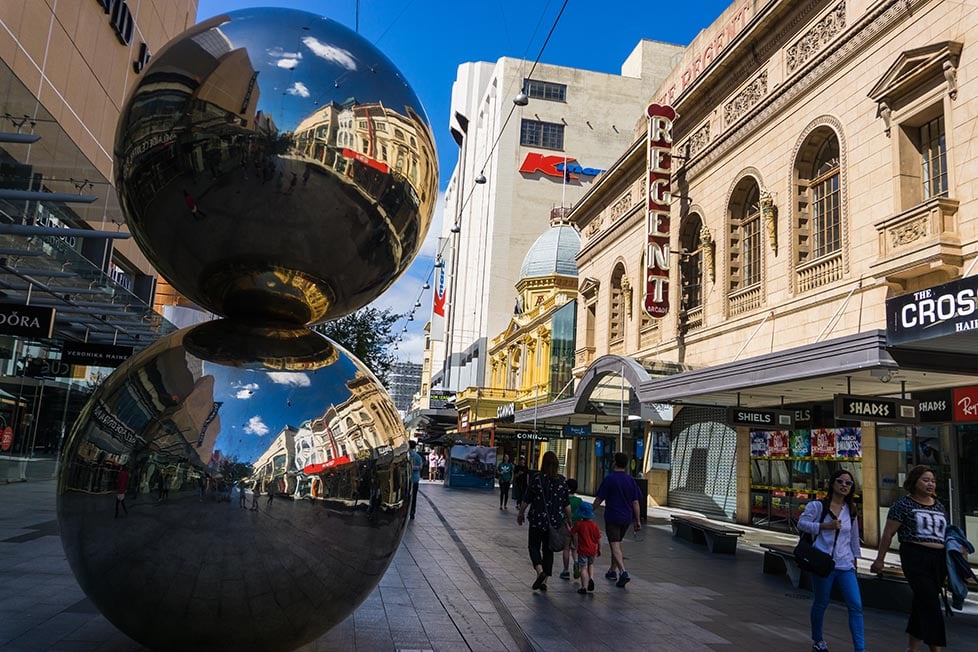
Image: Nic Hilditch-Short
Adelaide is a planned city – the first founded by freemen – and is extremely easy to get around. You can easily walk across the whole city proper in an hour or two.
A tour of Adelaide should definitely include a walk around one of the surrounding parklands, with lovely sights like the River Torres and the Botanic Gardens. For the best food and drink, look around the likes of Rundle Street, South Hutt Street, and O’Connell Street.
Adelaide has some of the best city beaches in Australia. Glenelg is a glitzy beach with lots of clubs and cafes. The most beautiful beaches though are found in the southerly suburbs around Brighton, Port Noarlunga, and Aldinga.
There is wine country everywhere outside of Adelaide. The Clare Valley, McLaren Vale, and Barossa Valley are the most prestigious regions and, between the three of them, produce the majority of Australia’s wine.
Hahndorf in the Adelaide Hills is another popular pastoral town, known more for its beer and German heritage.
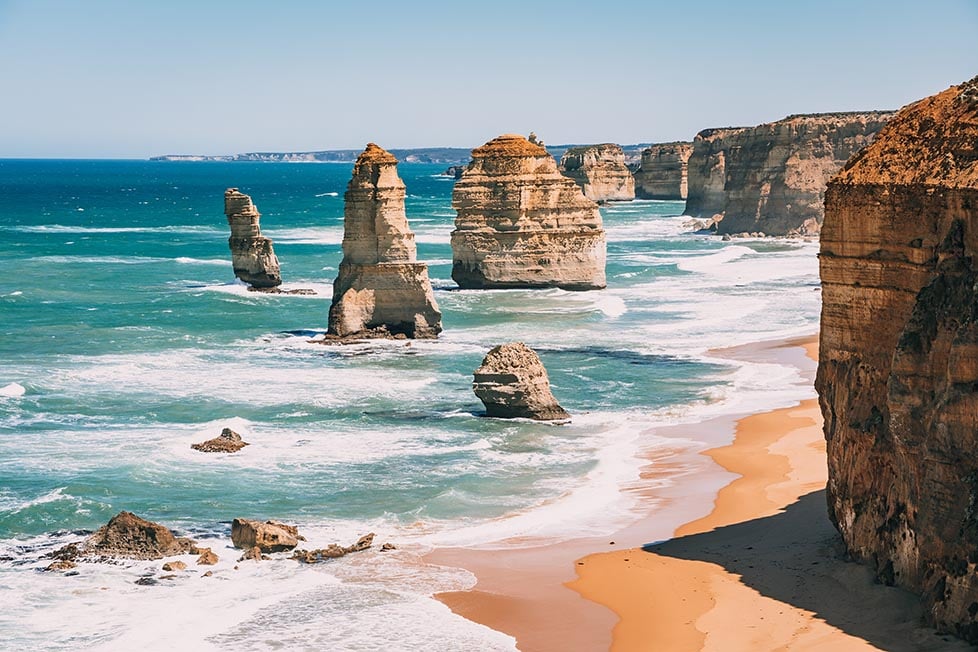
Image: Nic Hilditch-Short
You could fly, but I reckon a road trip from Melbourne is the best and most rewarding way to get here. Driving on the Great Ocean Road is a must-do while backpacking in Australia!
You’ll see several prominent landmarks and attractions while driving along the 150 miles of the Great Ocean Road. The most famous landmarks here are the Twelves Apostles: a group of limestone sea stacks that rise stunningly out of the ocean.
It’s one of many great Australian road trips. But this is one of my favourites.
 Read our hostel roundup for Adelaide.
Read our hostel roundup for Adelaide.
 And the best places to see in Adelaide.
And the best places to see in Adelaide.
 Plan the ultimate weekend in Adelaide.
Plan the ultimate weekend in Adelaide.
 Or read up on where to stay in Adelaide.
Or read up on where to stay in Adelaide.
Backpacking Kangaroo Island and the Yorke Peninsula
Within a day’s drive from Adelaide are the seaside getaways of the Yorke Peninsula, The Fleurieu Peninsula, and Kangaroo Island. Between the three areas, there are over six hundred miles of coastline. Most of these beaches are hardly visited or even touched by any sort of tourist.
The Yorke Peninsula is north of Adelaide. On a map, the Peninsula is easily recognizable due to its distinct shape – like a large tail, leg… or willy (to some people).
Economically, agriculture – not tourism – is the region’s leading enterprise. This has, for the most part, lead to the development of several small rural communities, which make for great backpacker bases.
Popular activities on the Yorke Peninsula include surfing, diving, fishing, and sampling the local produce. The surfing here, in particular, is some of the best in the state. Must-see locations on the Peninsula are Pondalowie Bay, Innes Australia National Park, and Berry Bay.

Kangaroo Island is a popular holiday spot for South Australians and is fairly unknown outside of the state. Located across from the Fleurieu Peninsula, it’s Australia’s third-largest island and an important refuge for several threatened ecosystems.
With highlands, rugged coastline, and a number of pristine beaches, the natural setting of Kangaroo Island is some of the prettiest in South Australia. Flinders Chase Park, Admirals Arch, and the Remarkable Rocks are among the most splendid sights on the islands – and shouldn’t be missed.
Arriving at Kangaroo Island is a simple matter of taking a short ferry from Cape Jervis. You’ll find most of the hostels in the largest settlement on the island, Kingscote. Local farm stays are becoming increasingly popular and many resemble hostels in their offerings.
Backpacking Uluru and Alice Springs
Smack dab in the “Red Center” of Australia, leagues away from any other city is Alice Springs. Never before has the term “middle of fucking nowhere” been more applicable.
Originally an outpost and then a military refuel base, it now serves as a hub for visiting the many desert wonders of the region, including the famous Uluru, previously known as Ayers Rock, changing it back to its aboriginal name.
Uluru is one of the most recognizable sights in Australia: it’s magnificent. Honestly, words don’t do this massive red rock justice – and the pictures do little either. Uluru is meant to be seen and felt in person; only then will you understand its significance.
As one local told me: “you stand there staring at (it) and then it begins to pulse. Uluru is the heartbeat of Australia.”

Image: Nic Hilditch-Short
Thankfully, tourists cannot climb Uluru with the restrictions in place right now. The local Aboriginal peoples, who hold the mountain sacred, adamantly requested and (at least for now) the battle is won. Many white Australians are respecting these wishes and you should too; walking around the base of the rock is still plenty enough.
There are other options that are equally as mystical and amazing like the Uluru Stargazing Astro Tour. You’ll get special access to the national park at night with an epic, unfiltered view of the cosmos.
NOTE: Uluru isn’t actually very near to Alice Springs. You’ll have to drive 6 hours to reach it… That’s Australia for you.
There are a number of other hikes around Alice Springs aside from Uluru. Kata Tjuta aka the Olgas and Kings Canyon are both definitely worth visiting as well.
The actual city isn’t much to write home about. Those expecting a weathered and rustic outpost in the middle of the harsh Outback will be upset to hear that the Springs is quite developed.
This infrastructure comes with a number of positives and negatives too including plenty of awesome Alice Springs hostels, swimming pools, and rampant racial tension, to name an unrelated few.
Backpacking Darwin
Darwin is the capital and largest city of the vast and empty Northern Territory. In an otherwise desolate place, Darwin exists today thanks to the booming mining industry and the need to create Asian shipping routes.
By most standards, Darwin is a small city with very few areas and attractions. The Wharf Precinct, Bicentennial Park, and/or one of the few museums may be worthwhile – but that’s about all.
If I’m being honest here, my impression of Darwin is that it serves primarily as a weekend getaway for pent-up miners and a base for backpackers trying to find work. The parties are, predictably, over the top in Darwin as both worker and traveler let loose.
It’s also the gateway to Kimberly, a vast and wild section of West Coast Australia that borders the Northern Territory. Many believe that this region contains the best of Australia’s Outback. With an area roughly equivalent to California and a huge array of natural sites, the Kimberly is a grand Australian adventure.
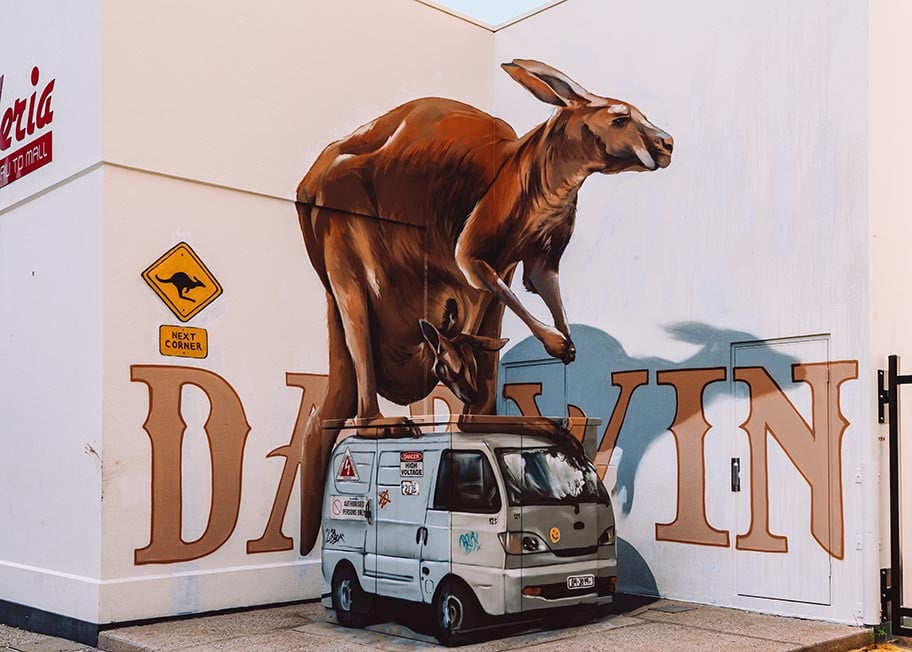
Image: Nic Hilditch-Short
The best part about backpacking Darwin is that it’s very close to some of the Outback’s best locations. Should you journey into the bush, bring excessive amounts of sunscreen and bug repellent: you’ll be miserable without them.
Kakadu National Park is widely considered a staple of the region and is a must-visit for those backpacking Australia. Ubirr, Jim Jim Falls, and the Gunlom Plunge Pool are among the best of Kakadu. Also worth visiting is Litchfield National Park, which is a lovely place full of waterfalls and swimming holes to cool off in.
Further south is the small town of Katherine. Here is the impressive Katherine Gorge, located within the Nitmiluk National Park. Travelers can experience the gorge in many ways from chartering a boat to paddling in a kayak to hiking along the rim of Jatbula Trail. That final option is a 4-5 day one-way hike.
Backpacking Exmouth and the Ningaloo Reef
Of a similar vein to Broome is the small community of Exmouth, located on the remote North West Cape. Here are some stunning beaches, awesomely rugged terrain, and, most importantly, one of the most precious ecosystems in Australia: the Ningaloo Reef.
Like Broome, Exmouth is a quiet beach town that swells in population during the four-month-long tourist season.
There are the usual civilized amenities here i.e. hotels, restaurants, bars, markets, etc. Exmouth also has a couple of city beaches – Town Beach and Mauritius Beach – but these are kind of lackluster. Eager backpackers ought to head directly to Cape Range and the Ningaloo Reef.
Cape Range National Park has some of the most beautiful beaches in Australia as well as some great hiking opportunities. All of the beaches of the Cape Range are seemingly perfect with brilliant white sand and crystal clear waters. Some superlative beaches include Turquoise Bay and Sandy Beach.
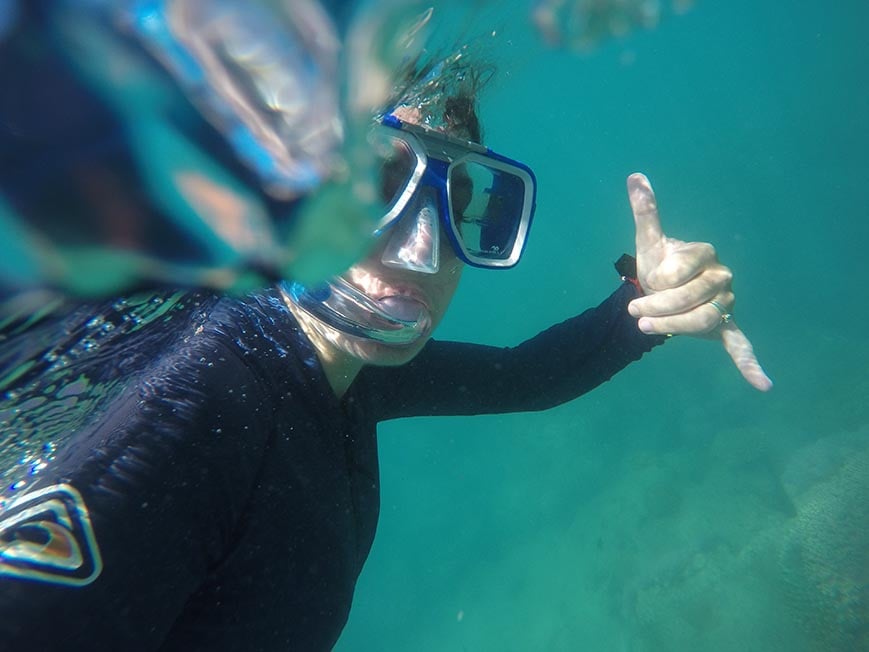
Image: Nic Hilditch-Short
Further inland, Cape Range has some wonderful canyons and gorges that make for great trekking spots. For the most popular hiking trails in the area, visit Charlie Knife Canyon, Yardie Creek Gorge, and Mandu Mandu Gorge.
Should you go snorkeling around Cape Range, chances are that you’ll stumble upon the beginnings of the majestic Ningaloo Reef. It’s home to some amazing marine life including whale sharks!
The coolest part about this reef is that it’s very close to the mainland. Unlike the Great Barrier Reef, which is 150 miles from Cairns, you can literally swim (safely) to the Ningaloo Reef from the beach in some places i.e. Coral Bay.
Having a watercraft will, of course, unlock, more of the Ningaloo Reef. There are a number of sailing companies around Exmouth and Coral Bay, though a kayak may be sufficient enough.
Backpacking Perth
Perth‘s primary claim to fame is that it’s considered one of (if not the most) isolated major cities in the world. It’s probably a good thing though; if Perth were any more accessible then it would definitely be overrun by now. With a booming economy, an extremely pleasant climate, and some of the most beautiful scenery in the whole country, Perth is certainly in the running for the best city to visit in Australia.
Aesthetically, Perth is great for backpacking since it’s a very attractive city. The CBD, with its ever-growing skyscrapers, rises elegantly on the banks of the Swan River. From King’s Park, which is very charming in its own right, the cityscape is totally laid out before you and yours to take in.
Inside the city itself, there are a few tourist sites of note. London Court is a lovely street built in Elizabethan fashion, complete with Tudor-style homes and coat-of-arms on the doors; obviously, not the most authentic of attractions… but pretty nonetheless.
Also worth seeing is the redeveloped Elizabeth Quay, which is Perth’s answer to the Sydney Harbor.

Image: Nic Hilditch-Short
For all its beauty, Perth is worth a weekend visit but, to be honest, the best parts are outside of the city anyways. To the north is Northbridge where you’ll find the best eats and nightlife in Perth.
Adjacent Fremantle is a separate destination in its own right (see the section below) and definitely somewhere worth checking out. From Fremantle, you can book a ferry to the idyllic Rottnest Island for the chance to see the smiling quokkas and some gorgeous beaches.
Speaking of beaches, Perth has some of the best in Australia. Scarborough and Cottesloe are the city’s most famous strips of sand. Mullaloo Beach and Pinnaroo Point are lesser-known but absolutely breathtaking.
 Read about Perth’s best places to visit.
Read about Perth’s best places to visit.
 Craft an expert travel itinerary for Perth.
Craft an expert travel itinerary for Perth.
 Book one of the best hostels in Perth.
Book one of the best hostels in Perth.
 Or read up on Perth’s best areas.
Or read up on Perth’s best areas.
Backpacking Tasmania
Off mainland Australia, Tasmania is Australia’s forgotten state – a bit of an afterthought that only evokes images of Looney Toon characters or barbarous locals it would seem.
This is for the best though as backpacking Tasmania is a true hidden gem. This is a paradise, with fantastic landscapes, eccentric people, and some world-class cuisine. Tasmania is one of the best places in Australia and no one knows about it!
Tasmania is an island state, separated from the mainland by the Bass Strait. The majority of the population (40%) lives in the Greater Hobart precinct, which serves as the state’s capital city.
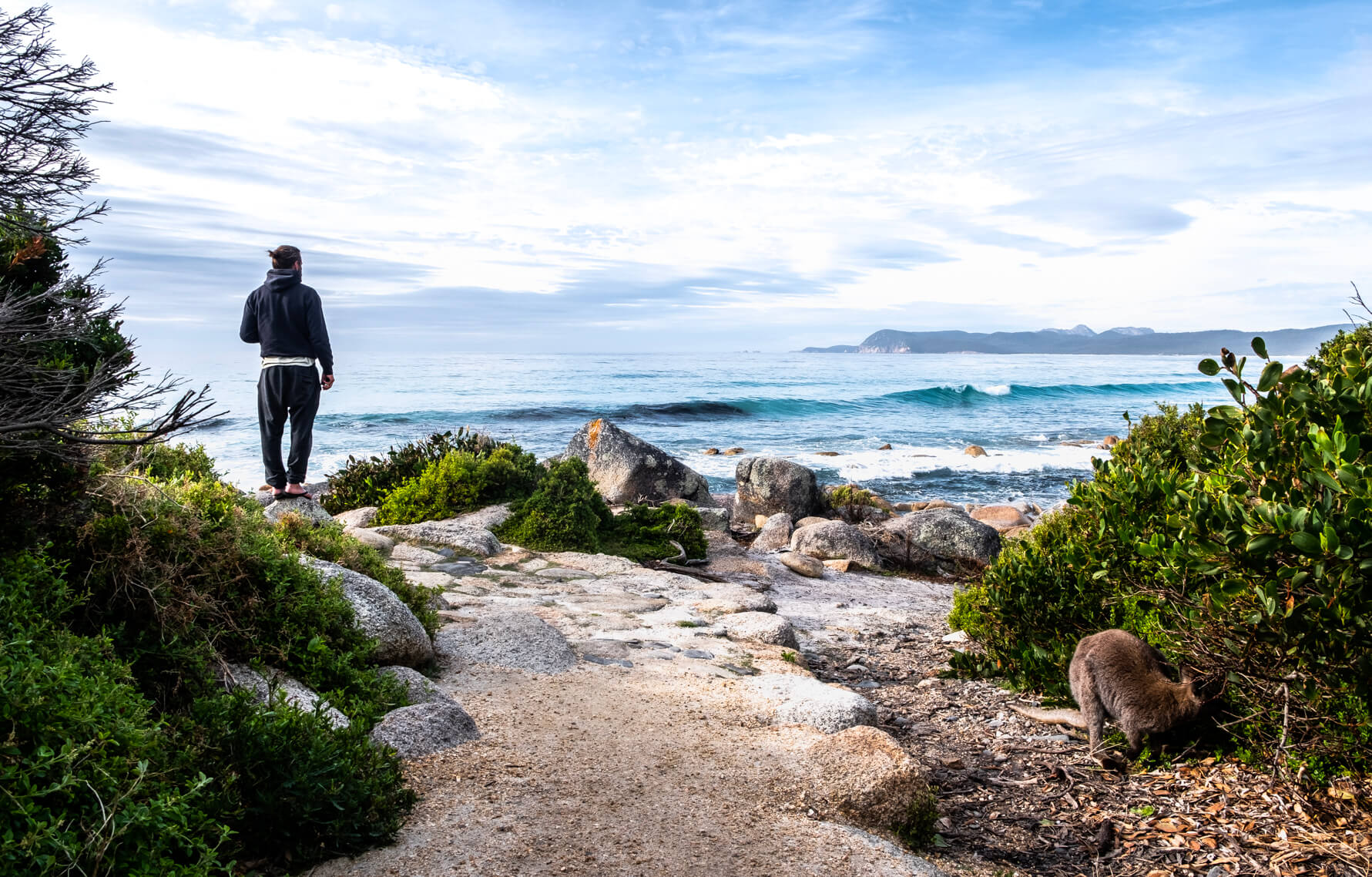
Photo: @themanwiththetinyguitar
Despite its separation from the rest of mainland Australia, Hobart is an awesome city carrying a similar vibe to Melbourne. Though not as big, there’s a lively undercurrent of culture to be found in its art and music scenes. It’s the perfect place to stay in Tasmania.
There are also heaps of awesome backpacker hostels in Hobart, and you’ll definitely meet some like-minded travelers for the onward adventures in Tassie.
Other settlements of note include Launceston, Bicheno, and Strahan, among other communes of varying sizes. Outside of these urban areas, Tasmania is mostly pristine wilderness, a good chunk of which is protected parkland or heritage site.
Tasmania is home to some very diverse geography. The interior of the island is very rugged, composed of jagged mountains and thick rainforests.
The coastline doesn’t disappoint either as some stunning beaches and bays here easily rival those of the mainland. So varied and stunning are the landscapes that Tasmania is often referred to as Little New Zealand.
Getting Off the Beaten Path in Australia
There’s a lot of nowhere in Australia, which means that there are lots of opportunities to get off the beaten path. With the proper vehicle and supplies, you’ll be able to make your own expeditions into the lesser-visited places of Australia.
Some off-the-beaten-track locations you must explore are Oz’s most mental national parks: the Mungo National Park, known for its alien rock formations and large dunes, and Lake Eyre, the largest and lowest lake in Australia that changes colour depending on the water level and salinity.
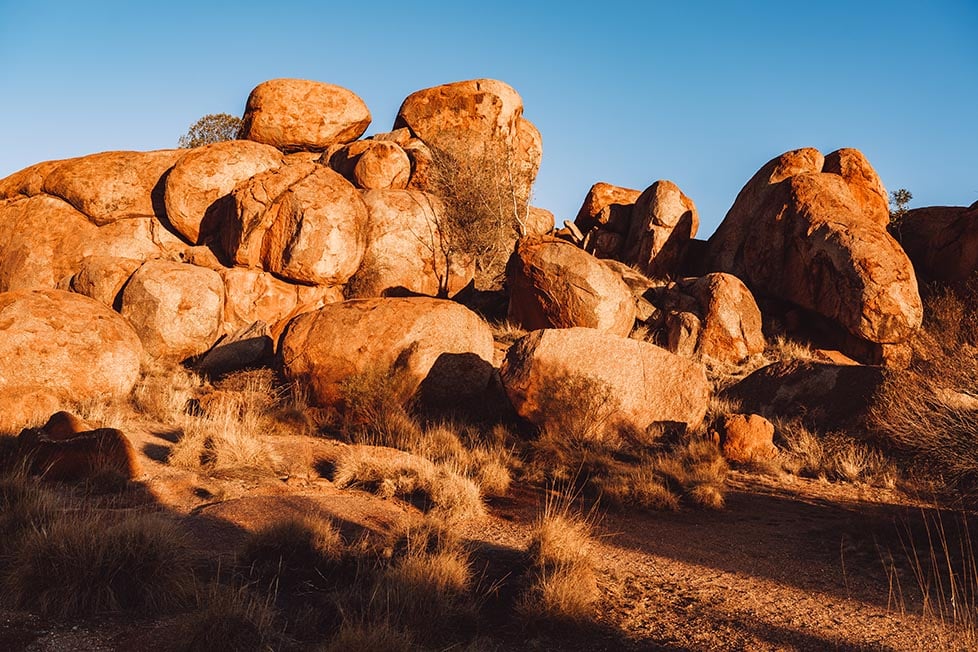
Image: Nic Hilditch-Short
The Flinders Ranges are home to the Wilpena Pound, a huge, natural amphitheatre that has to be seen to be believed. Coober Pedy is an old mining town that is famous for its swellings called “dugouts.”
The Karijini National Park is where you’ll find elegant gorges and breathtakingly vibrant rock, which makes this one of the most beautiful places in the outback. Speaking of Outback, you’ve heard of Uluru, but Mount Augustus is the real competitor. It’s larger but less prominent.
So as you can see, there are a ton of places to visit outside of the conventional. So get ready for some of the longest, bumpiest rides of your life as you go exploring the Australian nowhere!
Plus, if you can’t explore further out there are some great hidden gems in Sydney too for sure.

We’ve tested countless backpacks over the years, but there’s one that has always been the best and remains the best buy for adventurers: the broke backpacker-approved Osprey Aether and Ariel series.
Want more deetz on why these packs are so damn perfect? Then read our comprehensive review for the inside scoop!
View on Osprey10 Top Things to Do in Australia
There are so many things to do in Australia that narrowing it down to just ten of the best was no easy task. However, when you visit Australia, these are my top recommendations to leave yourself with some amazing memories to carry with you forever.
1. Visit Australia’s Outback
No backpacking trip to Australia would really be authentic without visiting the Outback. This is one of the harshest, most inhospitable landscapes in the world, and one of the defining features of the nation.

Image: Nic Hilditch-Short
Some of the most beautiful national parks in Australia, like Karijini, are only to be found in the Red Center as well. Rent a 4×4 and go mobbing in the desert!
2. Witness Uluru
Uluru is a true natural wonder and has to be seen in person. Make the long journey to this shrine and feel the power that it emits.
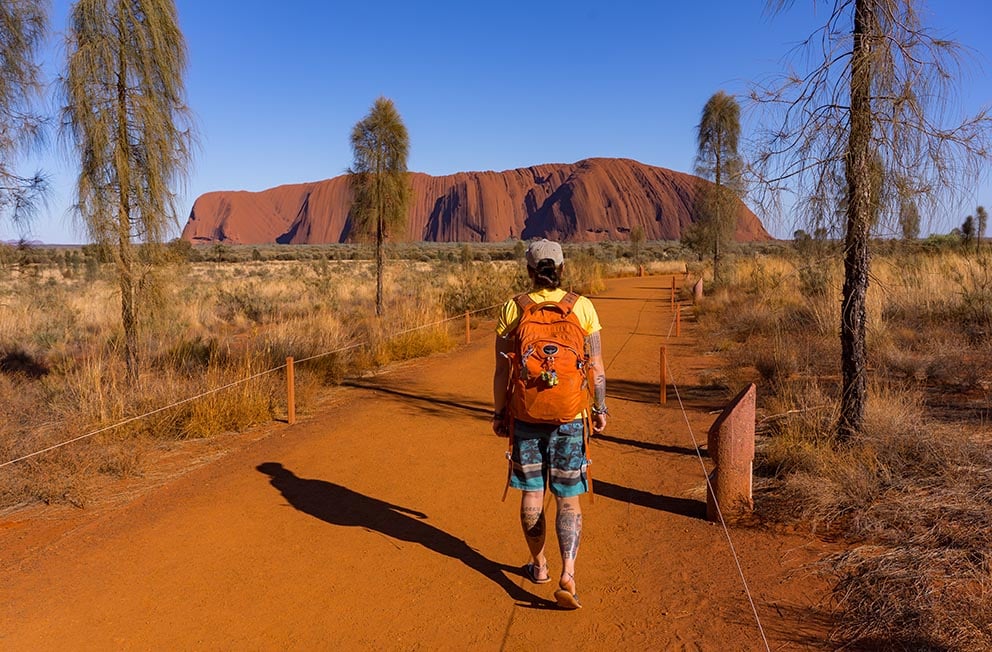
Image: Nic Hilditch-Short
I also recommend taking a camping trip and spending a night sleeping under the stars in a swag bag. Uluru is one of the few places that is not spoilt by city lights and so you’ll see the best night sky of your life.
3. Go Sailing in the Whitsunday Islands

Image: Nic Hilditch-Short
The Whitsunday Islands are absolutely drop-dead gorgeous and are one of the best places in Australia! Sail around the islands and be sure to visit Whitehaven Beach, which is one of the finest in the world.
Airlie Beach is a popular beach and gateway to the Whitsundays and the Great Barrier Reef. I personally struggled to drag myself away from here. It was one of the biggest, happiest memories of my life, smoking a doobie, looking out at the ocean, knowing I’m going to quit my job and travel full-time as soon as I got home.
4. Drink wine in South Australia
Yeeeeahhhh boooooyyy. South Australia is the wine country of Australia and produces some of the country’s most highly regarded vintages.
Visit one of the many wine regions surrounding Adelaide and try as much as you can! Spit or swallow… up to you.
5. Dive in the Great Barrier Reef or Ningaloo Reef
Both the Great Barrier Reef and Ningaloo Reef are amongst the most impressive ecosystems known to man. Diving in either one is sure to be an amazing experience. Enter an alien, underwater world, and be sure to have a waterproof camera!
6. Go surfing

Image: Nic Hilditch-Short
Surfing is one of Australia’s favorite pastimes and is practically the national sport! Anyone planning on backpacking around Australia simply has to try and get on board (see what I did there?). There’s a beach for every skill level and plenty of Aussies who love to show you the ropes.
7. Road trip!
Exploring Australia by car is the truest way to really experience the country. With your own set of wheels, you can go wherever you want and sleep wherever you want. As they say in Australia, “There’s a lot of fuck-all out there” so go and find it!
I suggest starting with a road trip around Queensland. It’s arguably the most popular route in Australia.
It’s a huge country, so you might not get to see all of it by road trip. Just heading from north to south will take weeks. Choose an area you want to explore the most, whether it’s an east or west-coast road trip, and go and explore!

Image: Nic Hilditch-Short
8. Discover Tasmania
Tasmania is one of the most beautiful places in Australia! This island is far more rugged than the mainland and is full of spectacular mountains, forests, and coastline. Journey here to see a different side of Australia.
9. Hike the beautiful national parks!
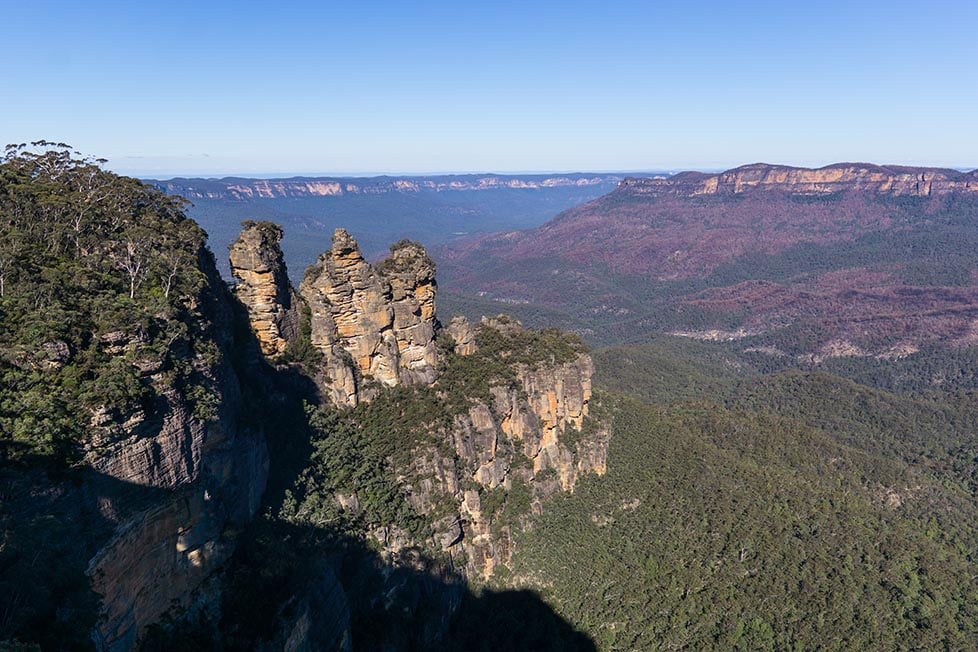
Image: Nic Hilditch-Short
There are many incredible national parks around the country. The most notable are the Blue Mountains, Nambung National Park, Karijini National Park, and Kakadu National Park.
Located to the west of Sydney, the New South Wales darling is the epic Blue Mountains National Park. The town of Katoomba is the gateway to the park, and home to the world-famous Echo Point lookout offers panoramic views of Jamison Valley.
Here you get the best view of the iconic rock formation of the Three Sisters, a sacred Aboriginal site. As well as being an area of outstanding natural beauty, the park has several bushland trails and incredible wildlife.
The Nambung National Park is most well known for its impressive rock formations in the desert, plus there are some stunning beaches near Kangaroo Point and Hangover Bay.
Karijini National Park is a vast wilderness in Western Australia, well known for its Weano Gorge, accessible by a hiking trail that leads to Handrail Pool. Kakadu National Park is a huge wetland in Northern Australia and the best place to see crocs in their natural habitat.
10. Have a fling… or a few… 😉
Hey, Australia is FULL of young, sexy, liberated backpackers, trying to figure themselves out. The chances of you stumbling across other backpackers that you think are mighty fine is very high. Sex in hostels in Australia is inevitable!
Be a slag… do whatever you want. Be free, just please be safe too.
Backpacker Accommodation in Australia
Australia is absolutely chalked full of backpacker lodges and hostels! These are among the best and most entertaining hostels in the entire world. People from every corner of the globe flock to Australia to party and have one of the grandest adventures of their life, be it in a city, on a beach, or in the Outback.
Australian hostels are of very high quality and are often the recipients of numerous backpacking awards. Most organize lots of events from pub crawls to game nights to communal dinners. There are very few hostels in Australia that I can really speak poorly of (feel free to ask me though).
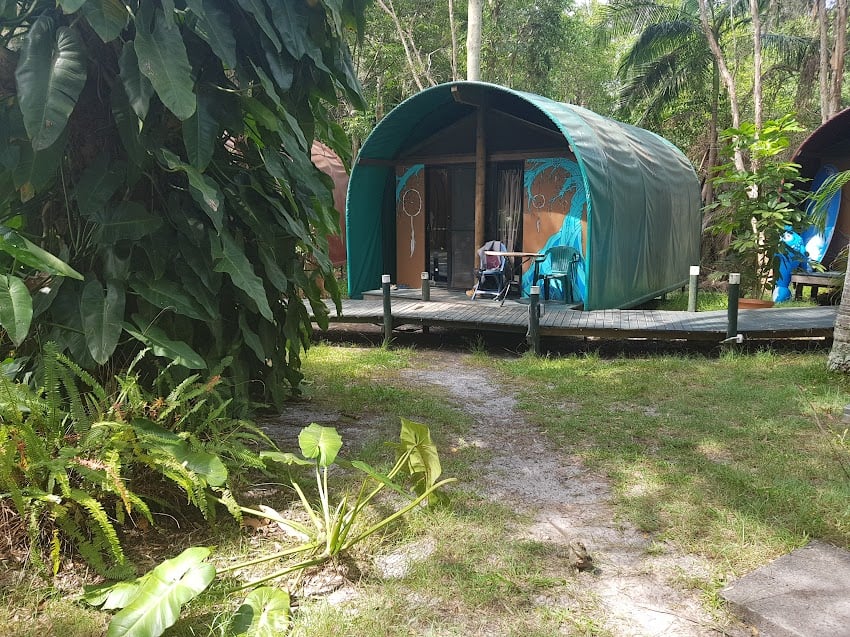
Photo: @Lauramcblonde
Couchsurfing is, of course, a very legitimate means of staying in Australian cities and is a great way to save some cash. Australians are an extremely welcoming bunch and have no problem inviting you over to their place for chicken parmy and a beer (or ten).
At the end of the day though, the best way to sleep in Australia is by camping, either with a quality backpacking tent or in a campervan. Australia has some of the most pristine and wonderful nature in the world and it needs to be experienced in the purest way possible. There’s nothing like sitting next to a fire in the bush and sleeping under the stars.
The Best Places to Stay in Australia
Not sure where to stay in Australia? Here are a few of my top recommendations!
| Destination | Why Visit? | Best Hostel | Best Private Stay |
|---|---|---|---|
| Adelaide | Cos it’s the gateway to the outback and is a cultural hub with excellent parklands, wine regions and some sick festivals! | YHA Adelaide Central | KT Apartments |
| Alice Springs | Alice Springs is home to the iconic Ayres Rock and is a great starting point for all your outback adventures in the bush. | Alice’s Secret Travellers Inn | Desert Palms |
| Brisbane | The capital of Queensland is a welcomed big-city stop amongst all the beach towns and is a popular backpacker hangout. | Brisbane Quarters | South Brisbane Apartments |
| Byron Bay | The “cool capital” of the East Coast is full of surfers, hippies and laid-back vibes. Byron Bay is 100% not to be missed. | The Surf House | Aloha Byron Bay |
| Darwin | Darwin is the capital of the Northern Territory and is a super cool hippy city with a super cool beach for super cool dudes. | Youth Shack Backpackers | City Gardens Apartments |
| Exmouth | Exmouth is a beach resort town with fabulous beaches and plenty of marine life. Oh, and Ningaolo Reef – EPIC! | – | Exmouth Escape Resort |
| Melbourne | Melbz is a gen-Z paradise. It’s artsy, vibey, has some amazing food, nightlife and is super diverse. The festivals aren’t bad. | The Mansion Melbourne | Sebel Melbourne Mavern |
| Perth | Sunny days, beautiful beaches, riverside parks, and a relaxed lifestyle all await your arrival in Western Australia’s capital. | Hostel G Perth | Lakeside Retreat |
| Sydney | The most famous city in Australia is full of grade-A sightseeing, activities and beaches. Sydney is absolutely unmissable! | Wake Up! Sydney Central | Meriton Suites |
| Townsville & Magnetic Island | Townsville has heaps of sick parties to attend before you head to Magnetic Island for its stunning landscapes and wildlife. | Selina Magnetic Island | Amaroo on Mandalay |
| Tasmania | Tasmania is a world of its own. Expect serene wilderness, unique wildlife and some seriously sexy starry skies. | YHA Hobart Central | Arthur River Spa Cottage |
| Broome | Cos it’s home to the iconic Cable Beach and some simply incredible surf spots that’ll make you wax up instantly. | Cable Beach Backpackers | Eco Beach Wilderness Retreat |
| Kangaroo Island & Yorke Peninsula | To see some awesome wildlife, duh! Kangaroos (of course), sea lions, koalas, penguins. You name it, it’s here. | KI Dragonfly Guesthouse | Villas on The Bay – Kingscote |
| Canberra | Australia’s capital city is surrounded by wildlife and nature. Inside the city are cool museums, galleries and monuments. | The Village Hostels Canberra | The Hamptons |
Australia Backpacking Costs
Traveling to Australia on a budget is doable – if you know a couple of frugal tricks. If you can stick to a regiment, a comfortable backpacker budget in Australia should be around $60-$80 per day. Doing so means sticking to hostels, cooking at home, and drinking goon, amongst other things.
A bunk bed will cost between $15-$30 per night depending on where you are. More popular destinations, like Melbourne and Sydney, are more expensive while most of Queensland and parts of Western Australia will be cheaper. Naturally, solo travel in Australia is often more expensive than when you pick up a travel buddy.
Australian restaurants are usually pretty expensive with the average meal costing around $10-$25. I strongly advise those that are backpacking around Australia to limit how much they dine out – the food is overpriced as fuck. You’ll save a heap of money if you cook for yourself.

Image: Nic Hilditch-Short
Partying is EXTREMELY expensive in Australia. Seriously, there’s a reason Australians do all the drugs when they travel: they’re too fucking expensive back home.
Cigarette prices are ridiculous and a beer is $7 AUD minimum. If you must drink, buy the cheap and ubiquitous boxed wines AKA goon – these will be your saving grace.
If you plan on participating in any of the classic Australian adventures, like diving at the Great Barrier Reef or sailing in the Whitsunday Islands, you will definitely be paying a pretty penny. The only thing to do is just save up as much as possible and then pick one or two of your favorites to participate in.
A Daily Budget in Australia
So, how much is Australia going to set you back? Here’s a rough estimate…
| Expense | Broke Backpacker | Frugal Traveler | Creature of Comfort |
|---|---|---|---|
| Accommodation | $10-$20 | $20-$30 | $35+ |
| Food | $8-$14 | $15-$20 | $25+ |
| Transport | $5-$15 | $15-$25 | $30+ |
| Nightlife Delights | $10-$20 | $20-$30 | $35+ |
| Activities | $0-$15 | $15-$30 | $40+ |
| Total per day: | $33-$84 | $85-$135 | $165+ |
Money in Australia
The official currency of Australia is the Australian dollar or AUD. Find out how much your money is worth today by using the up-to-date converter below. The value of the Australian dollar has fallen in recent years due to economic changes but the country is still prosperous and expensive by international standards.
ATMs are widely available and pulling out cash via a foreign card is an effortless affair. Most ATMs will charge a withdrawal fee on top of whatever international charges your bank imposes. Best to take out lots of cash at once to avoid paying too much in fees.

If you’re working in Australia, it’s very easy to set up a bank account. All of the major banking corporations – Commonwealth, Westpac, NAB, ANZ – have basic savings accounts that are very convenient and easy to use for those who are on a working holiday visa in Australia.
If you had a job while backpacking Australia, definitely make sure to do your taxes at the end of the fiscal year! Backpackers are usually entitled to a huge tax return (for reasons that are hard to explain) and it would be a real shame to walk away from a big payday.
For all matters of finance and accounting on the road, The Broke Backpacker strongly recommends Wise – The Artist Formerly Known as Transferwise! Our favourite online platform for holding funds, transferring money, and even paying for goods, Wise is a 100% FREE platform with considerably lower fees than Paypal or traditional banks.
But the real question is… is it better than Western Union? Yes, it most certainly is.
Travel Tips – Australia on a Budget
Australia is a country that can really eat into your wallet if you’re not careful, so make sure to follow these travel tips to save money and have even more fun.
- Camp: With plenty of gorgeous spots, Australia is a great place to have the right camping gear. You can also ask to pitch a tent in people’s yards. If you’re feeling really adventurous and want to save some cash, consider picking up a backpacking hammock.
- Cook your own food: If you are on a tight budget, you can save money by cooking your own food. I recommend bringing a portable backpacking stove.
- Book your transportation early: Both plane and train tickets are much cheaper if you purchase them in advance. This rule does not apply to buses, which you can often book within the day or even an hour.
- Couchsurf: Australians are awesome, but always check the reviews anyhow. Couchsurfing to make some real friendships and see this country from the perspective of locals. You can even ask (new) friends, or even friends of friends. This paid off for me plenty.
- Pack a travel water bottle: Save money – and the planet – every day!
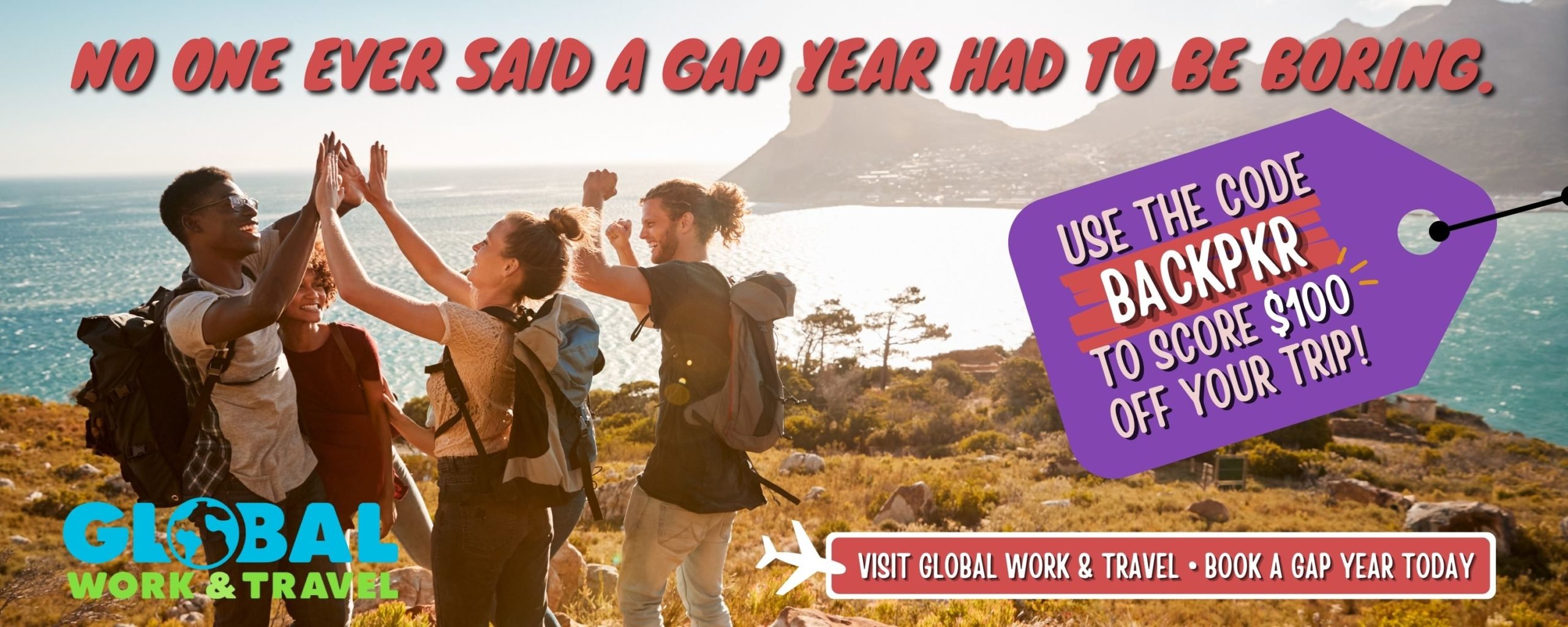
Why You Should Travel to Australia with a Water Bottle
Plastic is a problem. It washes up on Australia’s most pristine beaches and wraps itself around its fragile ecosystems.
You aren’t going to save the world overnight, but you can be part of the solution and not the problem. Being a responsible traveller is getting easier and easier with the support of our incredible network of inspiring individuals and other backpackers.
Plus, buying overpriced bottles of water from supermarkets isn’t fun either. Travel with a filtered water bottle instead, save money and potentially another lovely, little dolphin’s life.

Drink water from ANYWHERE. The Grayl Geopress is the worlds leading filtered water bottle protecting you from all manner of waterborne nasties.
Single-use plastic bottles are a MASSIVE threat to marine life. Be a part of the solution and travel with a filter water bottle. Save money and the environment!
We’ve tested the Geopress rigorously from the icy heights of Pakistan to the tropical jungles of Bali, and can confirm: it’s the best water bottle you’ll ever buy!
View on REI Read the ReviewAnd Speaking of Plastic… Get an eSIM For Australia
You know those tiny pieces of plastic you used to use to connect yourself to the internet abroad? Sim Cards I think they were called? Well yeah, we’re ditching those as well.

These days, wherever you go in the world an eSIM is by far the best way to stay connected from the minute you land. You can download an eSim before you leave home and then activate it when you are still sitting on the plane waiting to disembark.
You skip all the hassle of trying to figure out different providers and navigating airport prices to make sure you’re not getting scammed.
Of all the many eSim providers out there, we suggest Jetpac. Jetpac works just like an app: you download it, pick your plan, and BOOM! You’re connected before the pilot says you can stand up.
JetPac eSim Packages For Australia
1GB – 4 Days – $1
5GB – 30 Days $15
10GB – 30 Days – $23
Best Time to Travel to Australia
Australia has two distinct climate zones: a tropical one in the north and a more temperate one in the south. There are several microclimates found in each of these zones but, broadly speaking, they are still subject to the same sort of seasons. So when it comes to the best time to visit Australia, it’s not so simple!
Note that Australia is in the southern hemisphere. Australian summer ist from December-February and its winters are from June-August. With this in mind, its a great winter travel destination if you’re in the Northern Hemisphere and want to escape the bad weather.
The south of Australia – New South Wales, Victoria, South Australia, Tasmania, and (south) Western Australia – has a more temperate climate and usually has four seasons. In some places, like Perth and Sydney, these seasons can appear very similar to one another as the weather is pleasant year-round.
In other areas, like Melbourne or Tasmania, the weather is more unpredictable and even harsh at times, especially in the mountains. Melbourne famously gets “four seasons in one day.”
The north of Australia, including northern Queensland, Australia’s Northern Territory, and (north) Western Australia tropical and only has two distinct seasons: hot, wet summer and cool, dry winter.
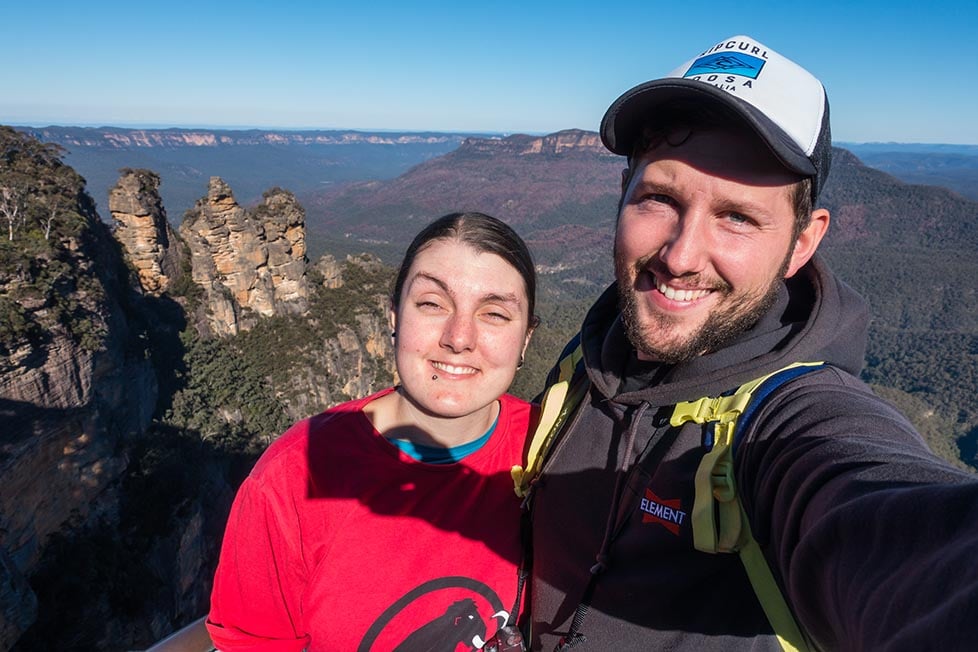
Image: Nic Hilditch-Short
Australian summers – referred to as the big wet – can be oppressively hot and some places receive biblical amounts of rainfall. The deadly box jellyfish also comes closer ashore in the summer resulting in near-complete beach closures.
Summer really isn’t a good time to visit the northern Australia. It’s much better to visit in the winter – referred to as the big dry – when it’s slightly cooler, drier, and devoid of deadly jellies.
Since the north is almost always visited in the winter, demand is very high during this time. Prices will be much higher because of the short supply so be sure to keep this in mind while planning your itinerary.
What to Pack for Australia
If you’re not careful, Australia’s wilderness will smack ya to next Monday. Get your packing for Australia right! On every adventure, there are six things I never go traveling without:
Ear Plugs
Snoring dorm-mates can ruin your nights rest and seriously damage the hostel experience. This is why I always travel with a pack of decent ear plugs.
Hanging Laundry Bag
Trust us, this is an absolute game changer. Super compact, a hanging mesh laundry bag stops your dirty clothes from stinking, you don’t know how much you need one of these… so just get it, thank us later.
Sea To Summit Micro Towel
Hostel towels are scummy and take forever to dry. Microfibre towels dry quickly, are compact, lightweight, and can be used as a blanket or yoga mat if need be.
Monopoly Deal
Forget about Poker! Monopoly Deal is the single best travel card game that we have ever played. Works with 2-5 players and guarantees happy days.
Grayl Geopress Water Bottle
Always travel with a water bottle! They save you money and reduce your plastic footprint on our planet. The Grayl Geopress acts as a purifier AND temperature regulator. Boom!
Staying Safe in Australia
Australia has a reputation for being full of deadly creatures that are out to get you at every turn: killer snakes, spiders, crocodiles, jellyfish, hell even kangaroos. It’s important to remember though that death at the hands of these animals is very sensationalized. Statistics don’t back up the hysteria.
Believe it or not, the common bee and wasp, not spiders, are actually the number one killers in Australia. The truth is: Australia and its wildlife aren’t nearly as terrifying as you think.
That being said, it is extremely important to take all cautionary advice with the utmost seriousness. If a sign or a local says that an area is dangerous, either because of sharks or crocs or whatever, then, for fuck’s sake, listen to them!
Australians have become day-to-day experts on what can kill you and how to avoid it. At the end of the day, just follow this easy advice: if you don’t see Australians doing it, then don’t do it.
The elements really are your biggest concern while backpacking in Australia. Not to scare you, but drowning is a risk in Australia as ocean currents are very strong.

Image: Nic Hilditch-Short
The water may seem calm but, get caught in a wild rip, and you can quickly get submerged or pushed out to sea. Swim in designated areas and check signs for ocean conditions.
As mentioned before, heat is a major problem in Australia. Temperatures can soar to unthinkable heights and atmospheric radiation is a serious threat here. Forest fires caused by dry conditions are a serious problem as well.
Sex, Drugs, and Rock ‘n’ Roll in Australia
Australians LOVE to party. At least once, we’ve seen a group of Australians getting blindly drunk and looking to score.
Some observers may have even thought to themselves: “how the hell are they still doing this?” or “for what possible reason would you do that?” Well, there is one, I assure you.
Drugs and alcohol in Australia are astronomically expensive. On average, a pint of beer is $7-$8 and a spirit is a couple of bucks more maybe. Cigarettes cost somewhere in the late teens; and don’t even get me started on the drugs.
These ridiculous prices are why you see Australians partying all the time outside of their country: everything is just so much cheaper abroad and so they go crazy.
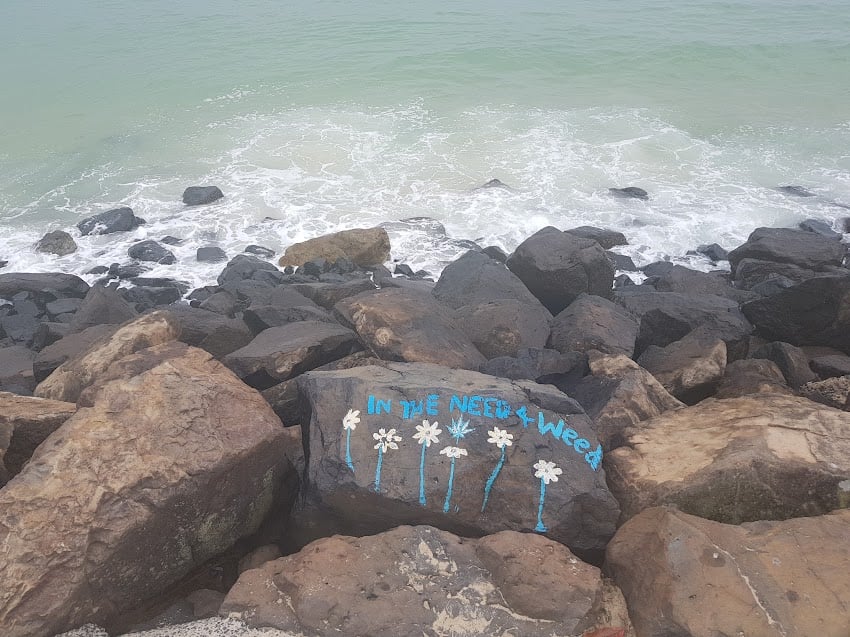
Photo: @Lauramcblonde
Prices are damned though, Australians still like to have a good time in their native land. Many go out in groups and buy rounds or shouts for one another.
If you plan on drinking with the locals while backpacking Australia, it’s very important to keep up with the shouts. Drinking a beer that someone has bought for you and not contributing to the shout is a dick move.
Be careful when drinking and driving as well. Australia has a zero-tolerance policy when it comes to drunk driving and any BAC over 0.05% will be met with harsh punishment. Random checkpoints are commonly set up at all times of the day to pull over drivers and check their sobriety.
Getting Insured BEFORE Visiting Australia
Traveling without insurance is never a good idea. It’s extremely risky. Check out good backpacker insurance sorted before you head off on an adventure.
ALWAYS sort out your backpacker insurance before your trip. There’s plenty to choose from in that department, but a good place to start is Safety Wing.
They offer month-to-month payments, no lock-in contracts, and require absolutely no itineraries: that’s the exact kind of insurance long-term travellers and digital nomads need.
SafetyWing is cheap, easy, and admin-free: just sign up lickety-split so you can get back to it!
Click the button below to learn more about SafetyWing’s setup or read our insider review for the full tasty scoop.
How to Get Into Australia
Getting into and around Australia can be a long and arduous affair. It is a good opportunity to make the most of a layover – many of them being in the Middle East or Asia.
Traveling to Australia from the USA is a 13-hour plane ride and it seems that every Australian city is at least 8 hours drive away from each other; Perth to Adelaide is a 1.5-day journey by car. Should you decide to travel to Australia, you’ll be staring at the back of the seat or an empty road for a while. But the moments in between make the whole trip worthwhile.

Image: Nic Hilditch-Short
Entry Requirements for Australia
There are several different types of tourist visas available to those who wish to go backpacking in Australia. The three primary tourist visa types are:
- Visitor visa (subclass 600)
- Electronic Travel Authority Visa (ETA) (subclass 601)
- eVisitor (subclass 651)
The 601 and 651 visas essentially function in the same way albeit with different application processes. The 600 is for those who want to stay in Australia for longer than 3 months at a time and for those who don’t qualify for either a 601 or 651. The grand majority of nationalities can apply for all of these visas online.
The ETA (601) and eVisitors (651) are the simplest and easiest visas to acquire. Both enable unlimited entries into Australia within the span of a year – the duration of stay cannot exceed 3 months at a time.

The biggest difference between these two types of visas is that they are only available to specific countries. Americans and Canadians, in addition to several other nations, must apply for an ETA. British, as well as most European citizens, must apply for an eVisitors visa.
The Visitor visa (600) is the most expensive of Australian visas but can grant the most time. Applicants can apply for a 3, 6, or 12-month duration at rates that vary from AUD140 to AUD1020. For any nation that doesn’t qualify for a 601 or 651, the 600 visa is the only means of entering Australia.
If you’re thinking of doing a working holiday in Australia, you’ll need to apply for a 462 or subclass 417 visa.
Upon arriving at customs, your visa will be checked and you’ll be subject to search. Australian customs takes declared items very seriously – so you must do so. Also, note that criminal offenses and felonies may bar you from entering the country.

Get 15% OFF when you book through our link — and support the site you love so dearly 😉
Booking.com is quickly becoming our go-to for accommodation. From cheap hostels to stylish homestays and nice hotels, they’ve got it all!
View on Booking.comHow to Get Around Australia
There are two ways of traveling in Australia and both offer widely different experiences. The first is by public transport i.e buses, trains, and planes and the other is with your own vehicle in the form of a rental car or campervan. The latter option is the vastly superior method.
Using public transport to travel outside and in between the major cities can be a tedious affair. Traveling by bus can be convenient and cheap so long as you’re staying on the East Coast where there are frequent stops.
Bus travel in the bush, which pretty much includes all of South Australia, Australia’s Northern Territory, and Western Australia, can be long and, in turn, pricey.
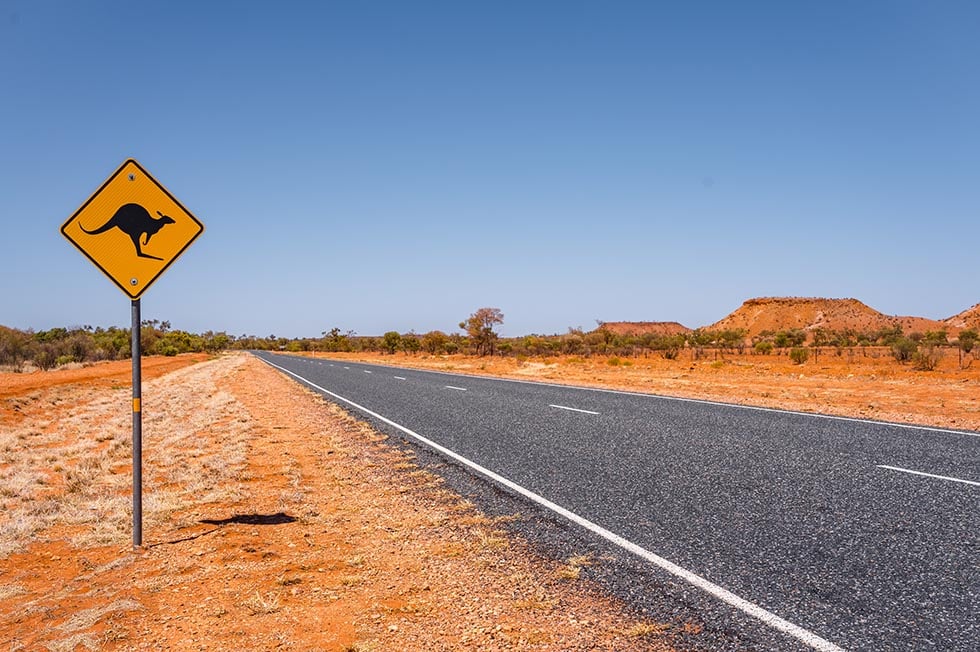
Image: Nic Hilditch-Short
Greyhound does offer hop-on-hop-off travel passes that can certainly be convenient. Check the rates at the official website and weigh the pros and cons of purchasing a pass.
Train travel is possible but this is a more luxurious form of travel i.e. more expensive. Taking the train in Australia is an experience in itself though and some long-distance routes, like the Ghan Train, can be very rewarding.
Flying is the primary means of getting around Australia due in part to the country’s size. Flights are relatively cheap and actually quite convenient.
Traveling by hitchhiking is a common practice in Australia. Make sure to follow the usual rules of the trade though and, as always, use common sense. Be wary of hitchhiking in the Outback – cars may be far and few in between and you could be in real trouble if you’re stuck out there in the baking sun.
Traveling by Campervan in Australia
By far the best way to get around Australia is by having your own vehicle. There are many car rental companies in Australia that offer long-term contracts. Each has a wide variety of vehicle types from sedans to 4x4s to campervans.
Campervans are definitely the most popular way of getting around Australia as they provide both transport and lodging at the same time. Living out of a campervan can be convenient, fun, and cheaper than conventional travel. By having the ability to sleep anywhere you want, you’ll save money and get more out of your Australian adventure.
Thanks to the plethora of rental companies available, it’s a breeze to hire a campervan while backpacking Australia. Most offer good rates, especially for longer periods of time.
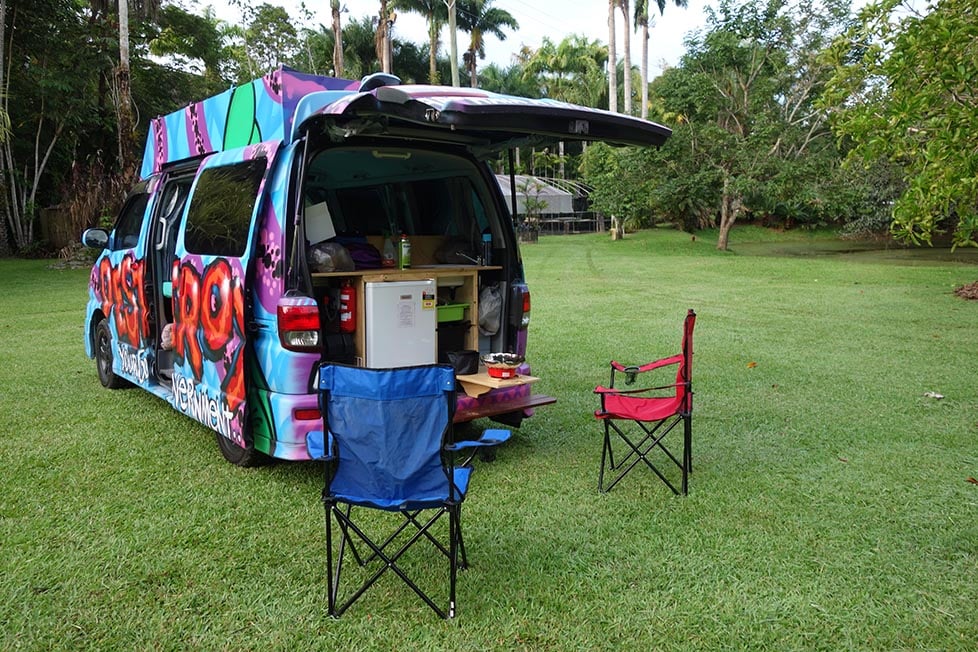
Image: Nic Hilditch-Short
I recommend going with JUCY Campers if you plan on renting a campervan in Australia. Make sure to check the contract though – many rental companies impose certain restrictions on going offroading and over a certain amount of miles per day and charge extra fees for not following these parameters.
If you plan on staying in Australia for a long time (more than 6 months) try buying your own campervan. Doing this will allow you more flexibility and, if you took care of the car, the chance to sell it when you’re done. You can find ads for used campers in many hostels and on online boards like gumtree.com.au.
When buying a camper, be sure to take the vehicle to the shop to get it checked before actually committing. Most auto shops are used to this kind of request and will charge a competitive fee.
Onwards Travel from Australia
Being the world’s largest island and a continent that consists of a single nation, there are not too many ways to get out of the country by land or sea. Luckily, Australia benefits from some very, very cheap international airline routes.
You can continue your backpacking journey in Oceania, but the cheapest and most convenient flights out of Australia are usually bound for Asian destinations. Budget Asian airlines, like AirAsia, in addition to Australia’s own budget airlines – Jetstar and Tiger – make traveling to Asia a breeze.
From any of the major Australian cities, and for as low as $100 sometimes, you can carry on your backpacking adventure in the likes of Indonesia, Japan, India, the Philippines, and even Pakistan! Seriously, you can get just about anywhere in Asia from Australia and for a great price.
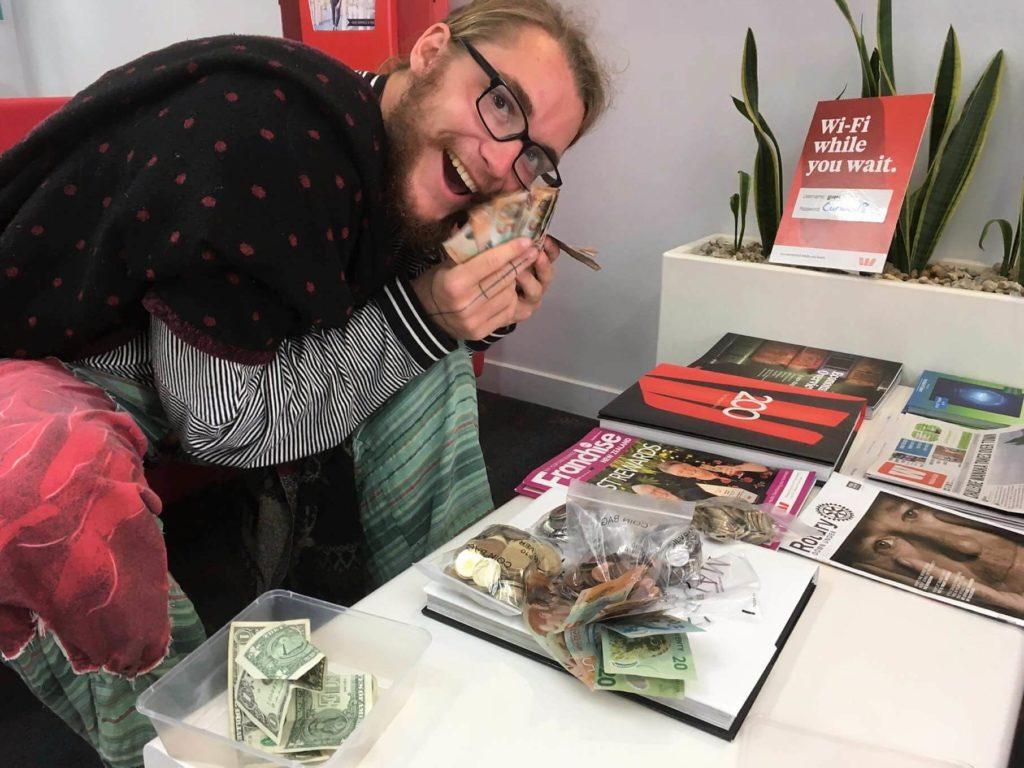
Photo: @themanwiththetinyguitar
Since AirAsia is so ridiculously cheap and popular, you’ll most likely end up connecting in its place of origin: Kuala Lumpur, Malaysia. Malaysia is a pretty cool spot and backpacking around the peninsula or on the island of Borneo is definitely worth trying.
Otherwise, you can get just about anywhere from Kuala Lumpur. If you aren’t connecting in KL, then you’ll most likely end up in Bangkok, Thailand, which certainly has its own reputation.
Asia aside, you can, of course, head across the Tasman to start backpacking in New Zealand. Backpacking around New Zealand is a very similar experience to Australia in that you’ll be paying the same prices and most likely living out of a campervan. Unlike Australia though, New Zealand has a wildly diverse geography and is much more temperate, both in terms of climate and native personality.
If you really want to go somewhere different, why not consider the Soloman Islands?!
Working in Australia
As a popular gap year destination, most backpackers need to earn a bit of money to continue their travels. They usually end up with fruit-picking jobs in Australia.
The work can be hard and life can be boring at times but the cost of living is quite low and those with a 417 visa will earn an extra year on their visa. If you can manage it, this is one of the best ways to have a working holiday in Australia!
Backpackers are so established in the fruit-picking industry and businessmen are in turn so reliant upon them that it’s usually very easy to find a job. There are dozens of online boards with postings for farm jobs in Australia. Some popular websites are:
When you arrive at your farm stay, you’ll probably be surprised. Many of these farms look like hostels complete with bunk rooms, communal areas, and recreations.
You’ll have to pay for a bed but the prices are very cheap. Sometimes you may have to sleep off-premises, in which case a car really comes in handy; otherwise, there’s always the bus.
You can make a decent living working on a farm. Most clear $600/week on average but a hard worker can definitely make more. Make no mistake though: this is difficult work.
Farming in Australia isn’t pretty but it can certainly be rewarding. You’ll become quite close to both the land and your fellow working backpackers.
Farm work isn’t the only means of making money in Australia. Some of the best jobs for a working visa in Australia include serving, nannying, cooking, and cleaning. If you’re really lucky, you may even find a job in mining. If you decide to work in the city, know that the costs of living will be much higher.

A new country, a new contract, a new piece of plastic – booooring. Instead, buy an eSIM!
Jetpac eSIMs work just like an app: you download it, pick your plan, and BOOM! You’re connected the minute you land. It’s that easy.
Read about how e-Sims work or click below to see one of the top eSIM providers on the market and ditch the plastic.
Grab an eSIM!Working Holiday Visas in Australia
Several nationalities have the option of applying for an Australian working holiday visa, which authorizes travelers to work legally in the country. This visa is an amazing opportunity for anyone who wants to stay and go backpacking in Australia for a longer term.
There are two types of working holiday visas in Australia:
- A Working Holiday visa (subclass 417)
- A Work and Holiday visa (subclass 462)
(If you’re thinking to yourself how stupidly similar these visa titles are, I’m right there with ya.)

Image: Nic Hilditch-Short
Both visas entitle visitors to the ability to work in Australia for a period of 12 months. Note that the possessor of a 417 or 462 can only hold a single job for a period of 6 months. Certain countries can only apply for a 417 or 462 i.e. the British can qualify for a 417 but Americans must apply for a 462.
To apply for either visa, applicants will need to show that they have at least AUD 5,000 in their bank account. Both visas will also require a bill of clean health and a clean criminal record.
Applicants for a 462 visa will need to provide some key additional details. With the exception of the United States, those applying for a 462 must provide a letter of support from their government.
462 applicants will also have to pass a character test in which they’ll need to prove that they’re of good moral quality. Usually, a certificate of excellence, like a diploma or special certification, will suffice for this.
The most important difference between a 417 and 462 is that possessors of the former can apply for a second year visa given they’ve met some criteria. Unfortunately, American citizens and other 462 applicants can only have a working holiday in Australia for up to a year.
If you’re finding all of this a bit complicated, Global Work and Travel can alleviate some of the visa complications for you. They offer working holidays and internship opportunities in many locations throughout Australia, both of which require the working holiday VISA.
In fact, they’ll support you throughout the entire process; from VISA guidance to finding you the perfect placement. You’ve got to be between the ages of 18 to 35 (30 for some countries) though… Apologies if this isn’t you!
Volunteering in Australia

Australia is volunteering gold – there are lots of different volunteer projects you can join whether it be teaching, animal care, agriculture, hospitality, tourism, or pretty much anything!
For finding gigs, you have several options:
- Workaway is crazy popular!
- Or WWOOF Australia is perfect for anyone interested in working on the land. Organic farms and permaculture are their wheelhouse!
- Most alternative sites to Workaway have oodles of options.
And of those alternatives, I have one favorite at The Broke Backpacker: Worldpackers!
Worldpackers like to put focus on community. They connect you with meaningful volunteering opportunities that really help you feel like you’re contributing to local communities. PLUS their platform comes loaded with nifty features for connecting volunteers too!
And for an extra saucy bonus on top, Broke Backpacker readers get a special discount of $10 – 20% of the annual signup fee!
Just use the discount code BROKEBACKPACKER at checkout or follow the button below and your membership is discounted from $49 a year to only $39. Make Down Under your stomping ground. 😉
Australian Culture
Australians are some of the most welcoming, exciting, and unabashed people that I’ve ever met. They have so few worries and give so little fucks that life just seems easier in their presence.
Even immediate dangers, like an impending tidal wave or the jaws of a killer croc, are made insignificant by an Australian’s devil-may-care attitude. 100%, these are some of the coolest people that I’ve come across in my travels.
It can be argued that the Australian attitude derives from their inhospitable environment. An Australian is threatened on a near day-to-day basis either from deadly creatures, ridiculous climate patterns, or people that constantly need to remind them of these last two points. After a while, danger itself just becomes commonplace and desensitizing.
The fact that Australia is so geographically remote as well means that hardly any international presence notices – or really holds – Australia accountable. Combine this with the Australian’s grit and you have a population that just does whatever makes them feel good.
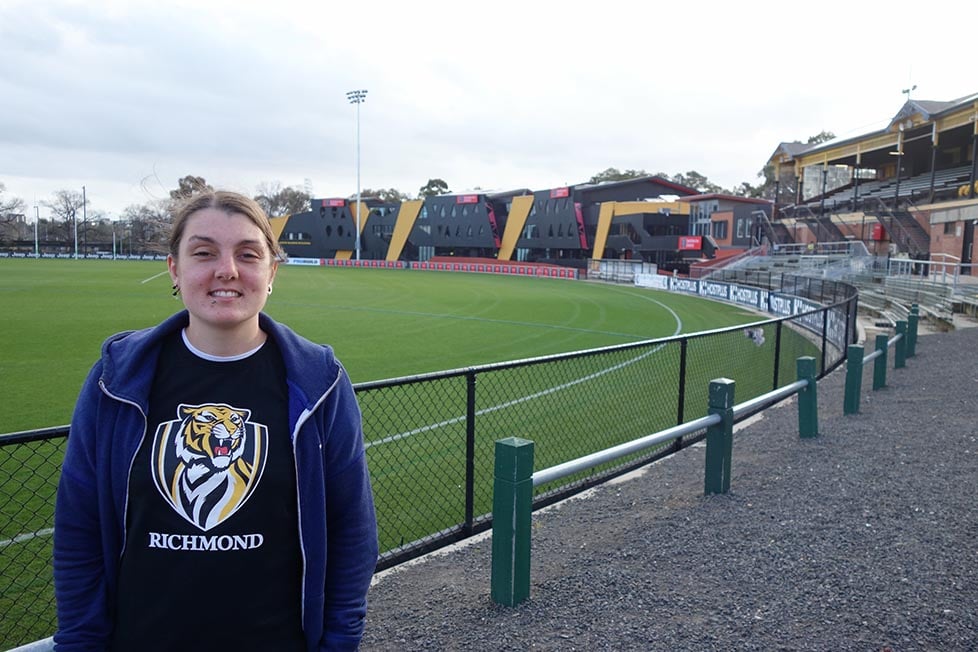
Image: Nic Hilditch-Short
To be fair, Australians who live in their home country are a little different from the ones that you see traveling so much. Rooted Australians are still hard workers and seemingly proficient at any trade involving blue-collar work. The country didn’t become so prosperous because they constantly didn’t give a shit.
We mustn’t forget either that Australia is inhabited by more than just white people and immigrants. Aboriginal people, the original Australians, are also present in modern Australian society, though to a smaller degree.
Odds are you won’t encounter many Aboriginal folks while backpacking through Australia; if you do though, just be respectful, open, and treat them the same as any other Ozzie.
Useful Travel Phrases for Australia: “That’s Not a Knife” Edition
The Australian accent is infamous and has been the subject of a million pop culture references. When asked to impersonate an Australian accent, most foreigners emulate caricatures like Crocodile Dundee or Steve Irwin.
Hate to break it to you, but the way in which many of these icons speak is either over-exaggerated or very demographically specific. Not every Australian yells “G’DAY MATE!” or puts so much twang into their voice when saying things like “like” or “right” or “fight.” These are cultural stereotypes and pretty unfair.
Australians use a lot of slang; so much so that sometimes it can be hard to understand them. You’ll catch on to the colloquialisms fairly quickly but, for a little extra help, I’ve included a list of some popular Australian slang.
- Ta – thank you
- Arvo – afternoon
- Bottle-O – liquor store
- Mozzie – mosquito
- Thong – flip-flops (yep, not the G-string)
- Ute – pickup truck
- Bathers – swimsuit
- Sheila – woman
- Chunder – vomit
- She’ll be right – everything will be fine
- Stubby – can of beer
- How ya goin? – a friendly greeting
What to Eat in Australia
Australian cuisine is heavily influenced by its colonial roots. English, Italian, Asian, and Greek styles are all present in modern-day Australian cooking to varying degrees.
Being a colony of the British Empire, Australian cuisine resembles most that of the English variety. Many staples like fish ‘n’ chips and meat pies are present in both. When dining out in Australia, expect a similar experience as if you were dining out in the UK. Australian food will be hearty, heavy comfort food.

Image: Nic Hilditch-Short
Being a nation of immigrants though, there is plenty more than the usual English fair. Asian cuisines of every shade are present in Australia and are actually some of the best outside of the Asian continent.
Several Mediterranean cultures call Australia home as well and have brought their cuisines with them. Thank the Italians for introducing a strong cafe culture in Australia – coffee in Australia is surprisingly delicious and taken seriously.
Barbecuing is a very important custom in Australia and is perhaps the highlight of the nation’s culinary scene. Aside from the usual BBQ meats, Australians also enjoy the various grilled game.
Kangaroo is healthy and cheap. Other more exotic meats like emu, alligator, and even grubs are available in speciality markets.
Must-Try Dishes in Australia
Below is a list of Australia’s most popular dishes.
- Meat Pie – Pastry, meat… self explanatory
- Chicken Schnitzel – The German fave
- Kangaroo – the dead, cute, bouncy guys
- Vegemite – a rite of passage – no spoilers
- Pavlova – the dessert that hits after a BBQ
- Anzac Biscuits – a little cookie treat for you sweeties
- Lamingtons – the cake you don’t need, but want
- Tim Tams – the old Ozzie classic
- Barramundi – your new fave fish dish
- Emu – big bird, long neck… you know the guy
A Brief History of Australia
Aboriginal Australians arrived on Australia’s mainland between 40,000 and 70,000 years ago. Their traditions relating to music, art, and spirituality are among the longest surviving in human history. Before the arrival of the British, the number of Aboriginal people living in Australia was between 300,000 and 1 million.
In 1770, Lieutenant James Cook claimed the land for Great Britain, after the Dutch first sighted Australia in 1606. In 1788, a fleet of 11 boats arrived in Botany Bay to establish New South Wales as a Penal Colony.
Furthermore, convicts were sent to all states, but South Australia became a free colony in 1836. More than 162,000 convicts were transported to Australia from Great Britain.
Australia began to look like a desirable location after the discovery of gold and the kickstart of its economy. The Eureka Stockade at Ballarat, in 1854, was a rebellion against taxation. Some see this as a crucial event in the evolution of Australia’s democracy.
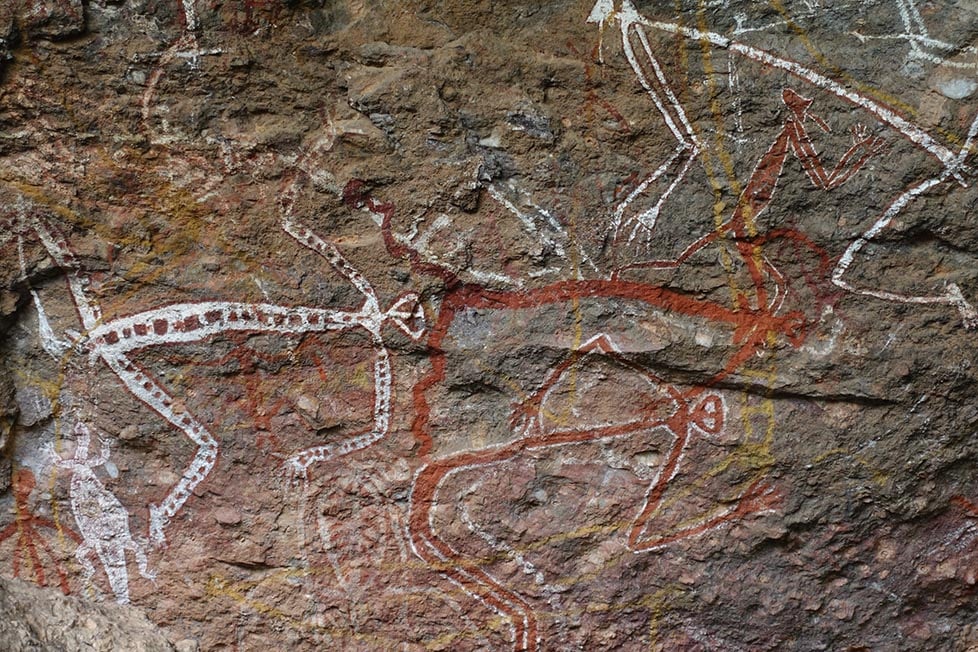
Image: Nic Hilditch-Short
Chinese immigration began during this period with 50,000 Chinese establishing roots in Australia.
In 1901, a federation of all of the states, the Commonwealth of Australia was created. The creation of Canberra marked it as the capital city of New South Wales, with a temporary parliament in Melbourne.
The Australian and New Zealand Anzac Corps took part in the World War I Gallipoli Campaign, in 1915. April 25, ANZAC Day, was the same date as the first landing at Gallipoli. Australians remember and pay their respects to the sacrifices of their armed forces on this day.
After World War II and the Vietnam War, an influx of migrants moved to Australia. Between 1949-1974, The Snowy Mountains Scheme employed 100,000 people. 70% of these people were migrants from 30 different nations.
Today, people from all over the world call Australia home. The continent has become known for its equality and lack of clear class distinctions.

Things go wrong on the road ALL THE TIME. Be prepared for what life throws at you.
Buy an AMK Travel Medical Kit before you head out on your next adventure – don’t be daft!
Buy on REISome Unique Experiences in Australia
No trip to Australia would be complete without taking on something new and exciting. If you’re tired of the usual tourist trail, consider checking out these unique experiences instead.
Trekking in Australia
Hiking, or bushwalking, is one of the most popular adventures in Australia! If you plan on going backpacking in Australia, you must go walking in the wilderness for a few days.
Venturing out into the bush in Australia is like taking a walk through the nation’s history. Here is a forbidding land, full of harsh landscapes and bitter elements, the likes of which tested and tortured the original settlers.
Should you decide to brave these wilds, you will gain real insight into the Australian identity. To enter the Australian backcountry you will need to be prepared.

Image: Nic Hilditch-Short
I always suggest getting a sturdy hiking backpack as well, especially so if you intend to venture deep into the wilderness. You’ll want the best you can find and not something that will eventually be held together by duct tape.
Below is a list of some of Australia’s best multi-day trails.
- Australian Alps Track (45-60 days, 406 miles) – Long and arduous hike that is only meant for the experienced or guided. Passes through the highest mountains of Australia. Requires food drops.
- Fraser Island Great Walk (5-7 days, 52 miles) – Walk across the entire length of Fraser Island, which is one of the most beautiful places in Australia.
- Larapinta Trail (16-20 days, 140 miles) – The ultimate Outback adventure! Fairly new trail and already one of the best in the country.
- Cape to Cape Track (6-8 days, 88 miles) – A stunning coastal walk that is conveniently located near Perth. Showcases some of the best scenery in the Margaret River region.
- Overland Track (5-8 days, 46 miles) – A walk through the finest mountain landscapes in Tasmania. Arguably the best trek in Australia.
Surfing in Australia
Surfing is as much a part of the Australian identity as kangaroos or shrimps on the barbie. Australia is extremely passionate when it comes to hanging ten and catching some waves.
Obviously, surfing didn’t develop in Australia by chance either; Australia has some of the finest beaches for surfing in the entire world and these attract thousands of surfers every year. You’ll have heard of the famous Byron Bay and its legendary surfing spots.

Photo: @joemiddlehurst
There are so many amazing surfing spots in Australia that it would seem more logical to note where you couldn’t actually surf. Everywhere you go there seems to be good breaks and swells.
Of course, you won’t be surfing in the Sydney Harbour or Melbourne Pier. But travel less than an hour and, boom, you’ll be right in the middle of some prime waves.
Below is a list of some of Australia’s top surfing locations. There’s a pretty diverse selection from all over the country. Though the Northern Territory is lacking in this regard.
| Where to Go Surfing | Location | Why Surf Here?! |
|---|---|---|
| Sydney Northern Beaches | New South Wales | Some of the best surf in NSW and still technically within the city of Sydney. Check out Manly and Palm Beaches. |
| Central Coast | New South Wales | Very popular surf spot in NSW. See Avalon and Copacabana Beaches. |
| Lennox | New South Wales | Small village near Byron Bay. Surf has powerful right-hand breaks. |
| Gold Coast | Queensland | They didn’t call this area “surfer’s paradise” for no reason. Definitely visit Snapper Rocks, Duranbah, and Burleigh Heads. |
| Noosa Heads | Queensland | Popular among long boarders. Visit Tea Tree Bay and Granite Bay. |
| Bells Beach, Torquay | Victoria | Spiritual birthplace of Australian surfing. |
| Victor Harbor | South Australia | Excellent surf on the Fleurieu Peninsula. Check out Knights Beach and Waitpinga Beach. |
| Rottnest Island | Western Australia | Quiet and low-key. Check out Strickland Bay, Salmon Bay and Stark Bay. |
| Margaret River | Western Australia | Great surf for all surfer skill levels. Visit Cape Naturaliste, Yallingup Beach, and Smiths Beach. |
| Marrawah | Tasmania | Biggest waves in Tasmania. |
Diving in Australia
Though the Great Barrier Reef on the East Coast receives the lion’s share of attention, there are plenty more options to go diving in Australia! Sprinkled throughout the Australian coastline are many gorgeous reefs, sunken ships, and sea caves that are just waiting to be explored.
These destinations definitely get far fewer tourists than the Great Barrier Reef and far more diving enthusiasts. You could even charter your own yacht and go snorkeling in several places along the East Coast if you’re more into snorkelling than diving.
If you’re really into diving, then definitely check out any one of these spots (that aren’t the Great Barrier)!
| Where to Go Diving | Location | Why Dive Here?! |
|---|---|---|
| Julian Rocks | Byron Bay, NSW | Famed their rich diversity of maritime life. |
| Fish Rock | South West Rocks, NSW | Best sea cave for diving in Australia. |
| SS Yongala | Townsville, Queensland | Enormous wreck that has become of the world’s greatest artificial reefs. |
| Osprey Reef | Far north of Queensland | Renowned for its huge shark population. |
| Piccaninnie Ponds | Mount Gambier, South Australia | Crystal-clear freshwater lake in South Australia. |
| Ningaloo Reef | Exmouth-Coral Bay, Western Australia | One of the few places that can rival the Great Barrier Reef. Comes very close to the beach. |
Backpacking the Outback
The Outback. The Bush. The Fuck-all Middle of Straya. The reason why most who want to go backpacking in Australia visit in the first place. Many have little clue though as to how large and how imposing this region actually is.
Few actually comprehend the Outback’s size or its conditions. That scene in the Inbetweeners Movie where Jay pisses on Simon’s face to survive springs to mind.
Though the exact number isn’t agreed upon, the Outback constitutes at least 70% of Australia’s landmass and is around 2-3 million square miles. The whole of India is 1.5 million square miles – that’s a lot of fuck-all!
Water is extremely sparse in the Outback. Temperatures vary widely depending on the season and time of year, from sub-zero to over 110 Fahrenheit. People die out here from exposure all the time. If you plan to venture out into the desert, you must be prepared.

Image: Nic Hilditch-Short
The Outback isn’t a singular destination that you just include in an itinerary – it’s a collection of several desert regions that form an unfathomably large ecosystem. You can visit parts of the Outback but there’s no way that you could visit the whole thing; there are huge swathes of the Outback that haven’t even been charted yet.
A few of the Outback’s top destinations have already been covered in this guide, like Alice Springs, the Kimberly, and the Nullarbor Plain. The last remaining portions of the Outback are relatively accessible. These places are, of course, minuscule in the grand scheme of things.
Join an Organized Tour in Australia
For most countries, when you visit Australia, solo travel is the name of the game. That said, if you are short on time, energy, or just want to be part of an awesome group of travelers, you can opt to join an organized tour.
Joining a tour is a great way to see the majority of the country quickly and without the effort that goes into planning a backpacking trip. However—not all tour operators are created equal—that is for sure.
G Adventures is a solid down-to-earth tour company catering to backpackers just like you, and their prices and itineraries reflect the interests of the backpacker crowd. You can score some pretty sweet deals on epic trips in Australia for a fraction of the price of what other tour operators charge.
FAQs About Backpacking Australia
Here are what people usually ask me about backpacking in Australia…
Final Advice Before Visiting Australia
I bloody love Australians, dude. Who else is happily willing to drink a beer from their sweaty shoe, just for a laugh? What a sick nation of people.
It would take a lot of effort to really piss off an Australian. Time after time, Australians just roll with the punches (quite literally sometimes), and then proceed to take a piss and forget about whatever may have had a chance of bothering them.
That being said, it’s still important to act like a decent human being and to show respect. No one likes an asshole coming into their country and stirring shit up.
Backpackers especially have been criticized because of their behavior and causing trouble. Let’s not be one of them dumbasses.
On a different note, be sure to tread lightly when it comes to interacting with Aboriginal Australians. They have been subject to unthinkable horrors in the past and are still treating the racial scars that are leftover. Though some White Australians still wallow in ignorance, Australia as a whole is trying to mend the gap.
Should you encounter an Aboriginal Australian and they’re open to conversation, be mindful of their customs and do your research on their terminology. Don’t take pictures or enter Aboriginal land without asking first. Be sure to speak using respectful language as well.
Other than that, have fun! Australia is a huge and diverse country with so much to explore and enjoy. No matter who you are or what you’re into, you’ll have a blast down under.

Image: Nic Hilditch-Short
Buy Us a Coffee!
A couple of you lovely readers suggested we set up a tip jar for direct support as an alternative to booking through our links. So we created one!
You can now buy The Broke Backpacker a coffee. If you like and use our content to plan your trips, it’s a much appreciated way to show appreciation 🙂




